Backlinks bring authority to your site. Which can help boost your rankings.
However, your backlink strategy should focus on quality. Not quantity. So you’ll need to use effective link building techniques to find the right backlink prospects. And get results.
Read on to learn eight of our favorite link building tactics for 2023.
1. Outreach
Outreach is when you contact relevant websites and ask them to link to your site. Most link building strategies involve outreach in some way.
Be sure to provide a strong reason to link to your content in your pitch.
Ask yourself:
What makes your content unique?
Is it original? In-depth? An up-to-**** resource?
Be specific in your pitch.
Because if you don’t give people a good reason to link to you, your outreach campaigns may not succeed.
Not sure who to reach out to? Use Semrush’s Link Building Tool to find potential prospects and manage your link building campaign.
First, click “+ Create project.”
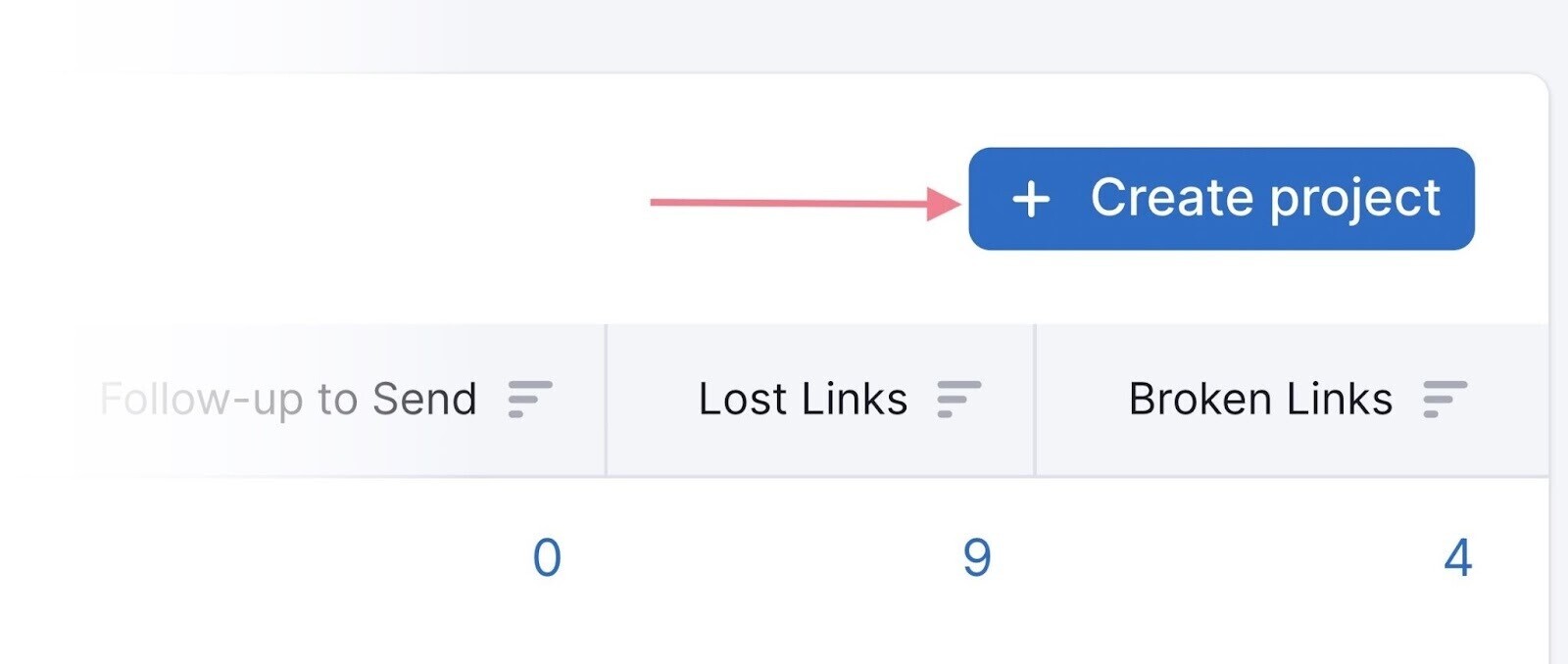
Enter your domain and name your project.
Click “Create project” again.
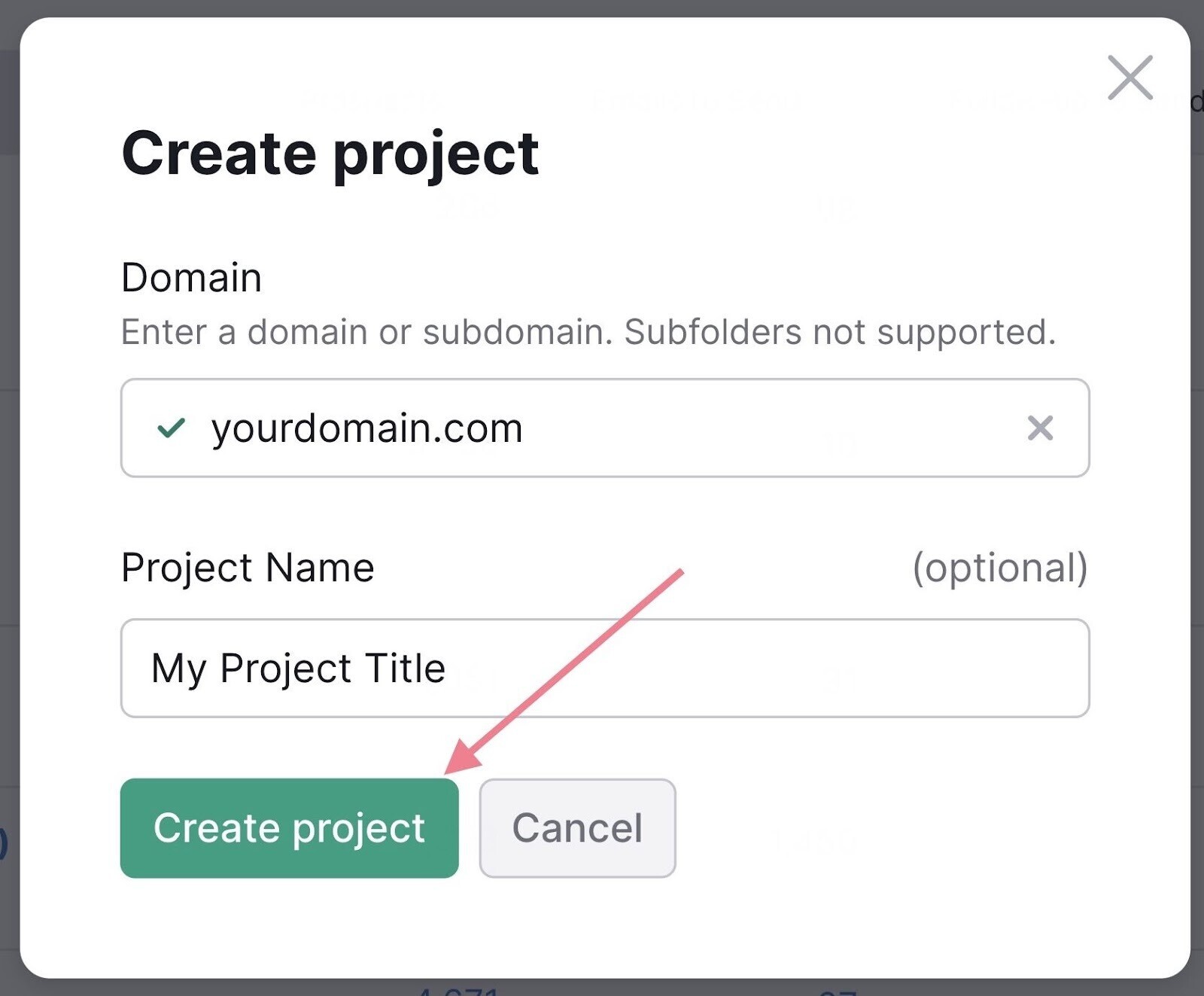
Next, add keywords.
The keywords should be related to the pages you’re trying to build links for.
Let’s say you want to build links to your weight loss guide.
Keywords could include “easy ways to lose weight,” “how to lose weight,” etc.
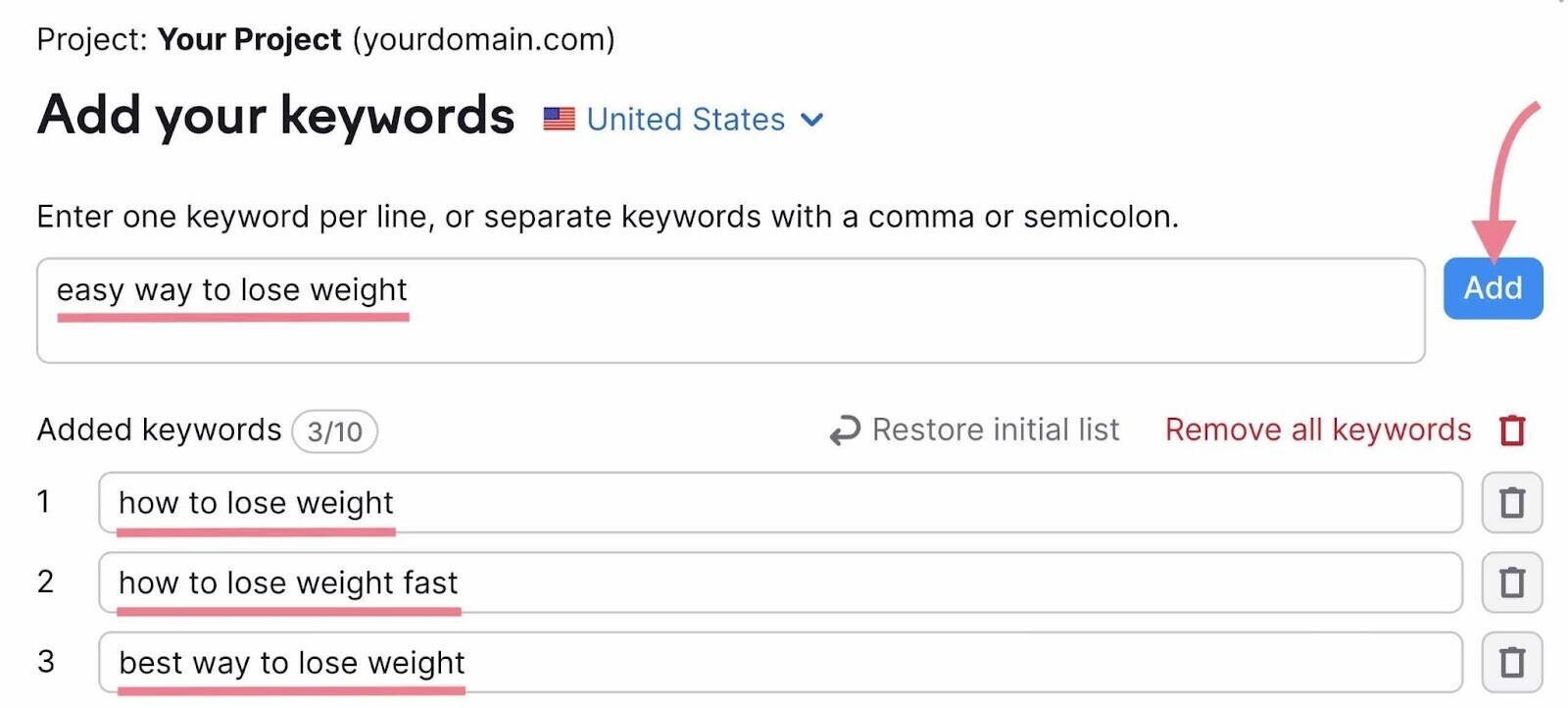
Tip: Read our keyword research guide for additional guidance.
After you add keywords, click “Competitors” at the bottom of the screen.
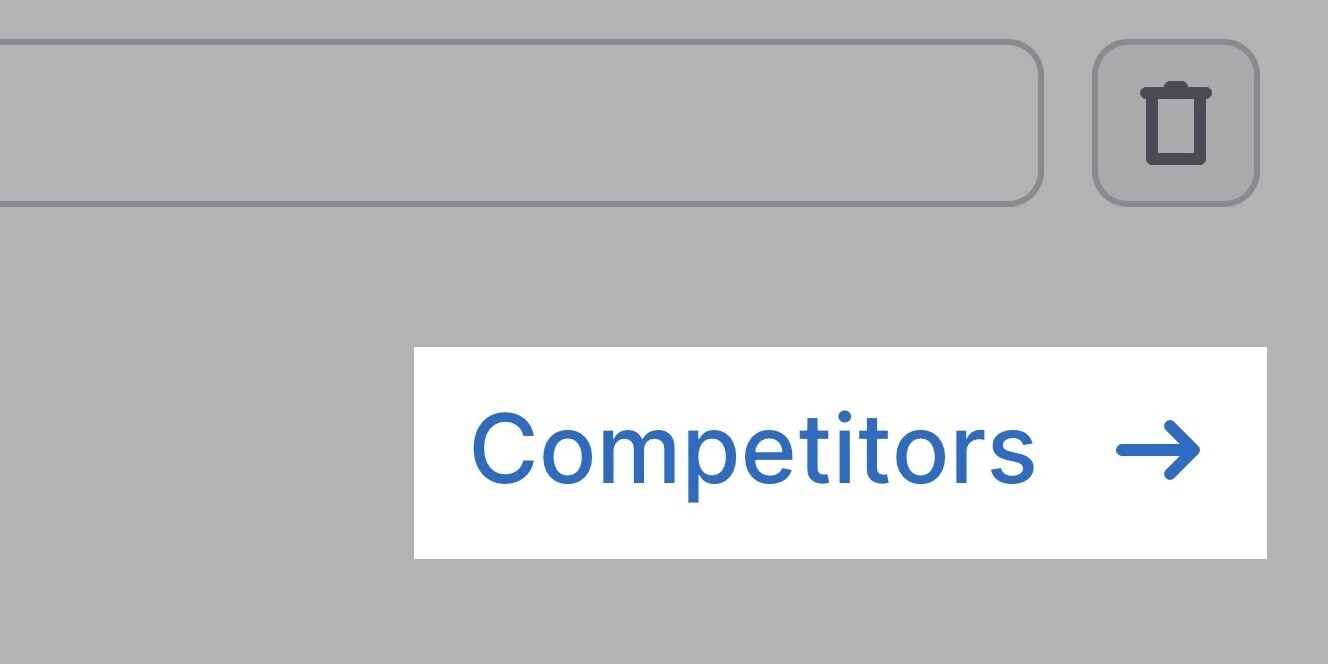
And add the competitors you want to outrank. (Read our competitor research guide if you haven’t already identified them.)
After you’ve added your competitors, click “Start Link Building.”
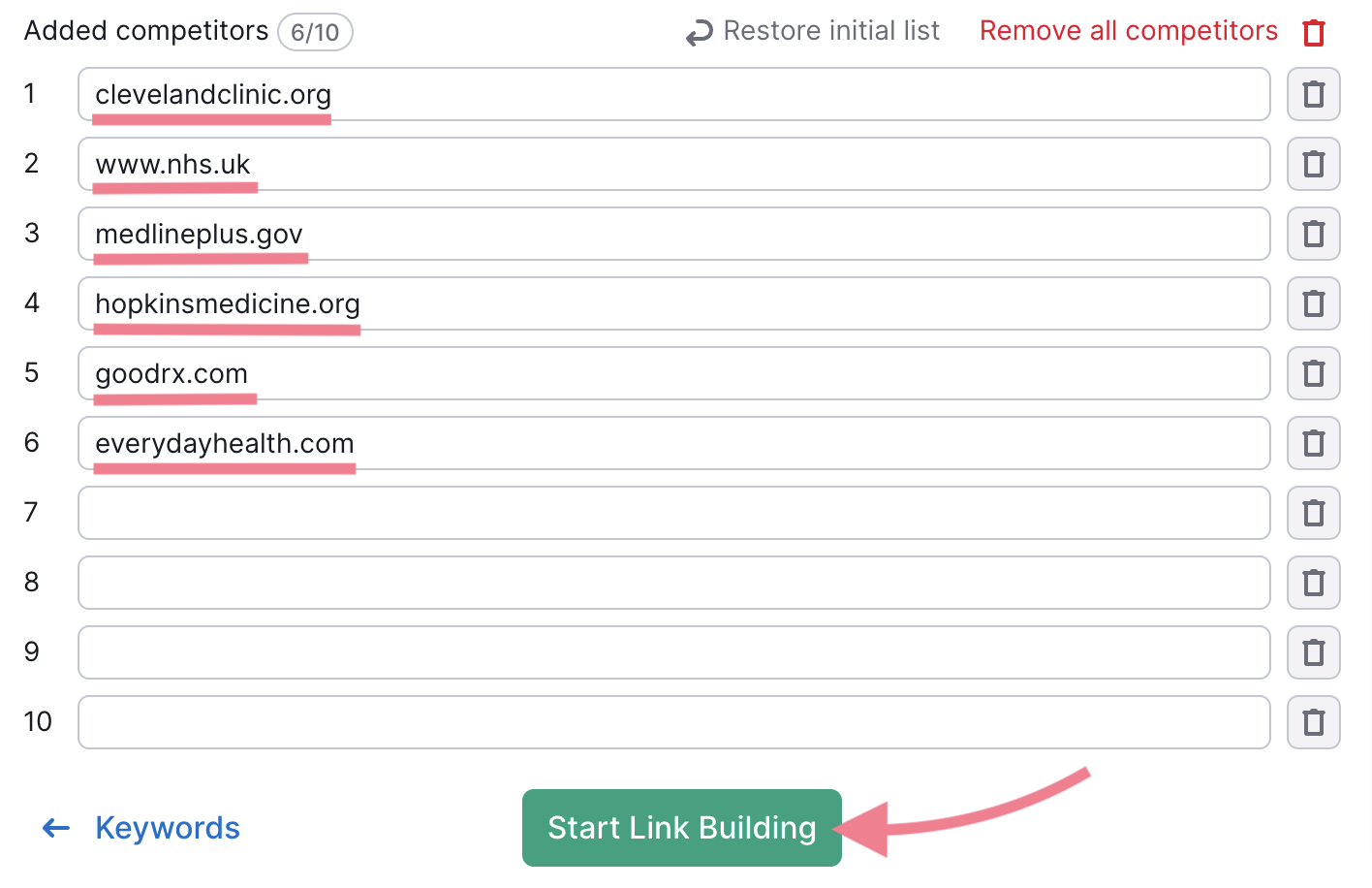
The tool will collect and analyze the data. When you see the confirmation pop-up, click “View prospects.”

You’ll then see suggested websites to reach out to for backlinks.
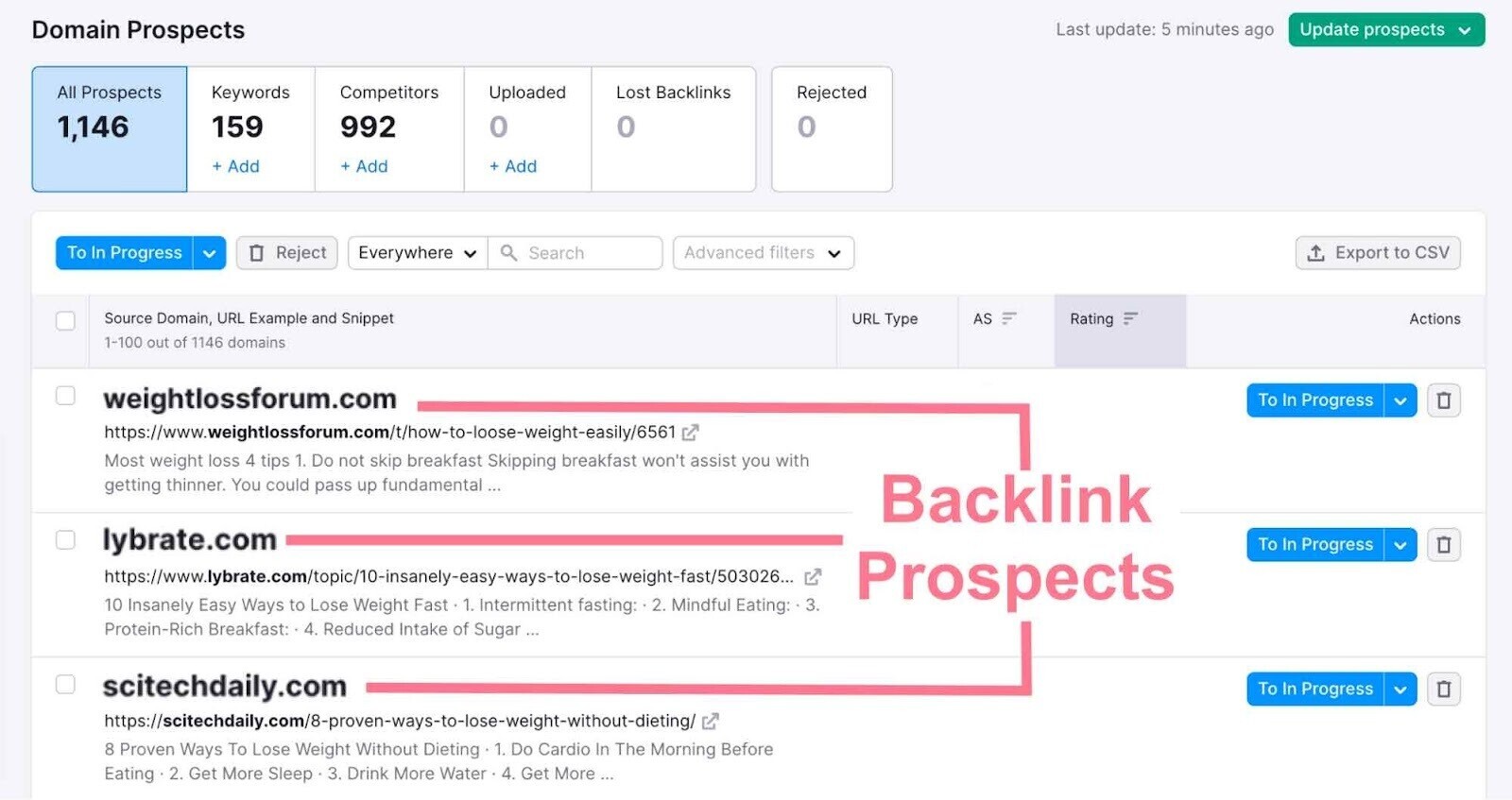
Manually review the results. To begin the outreach process for a particular website, click on the corresponding “To In Progress” button in the “Actions” column. And the prospect will be moved to the “In Progress” tab.
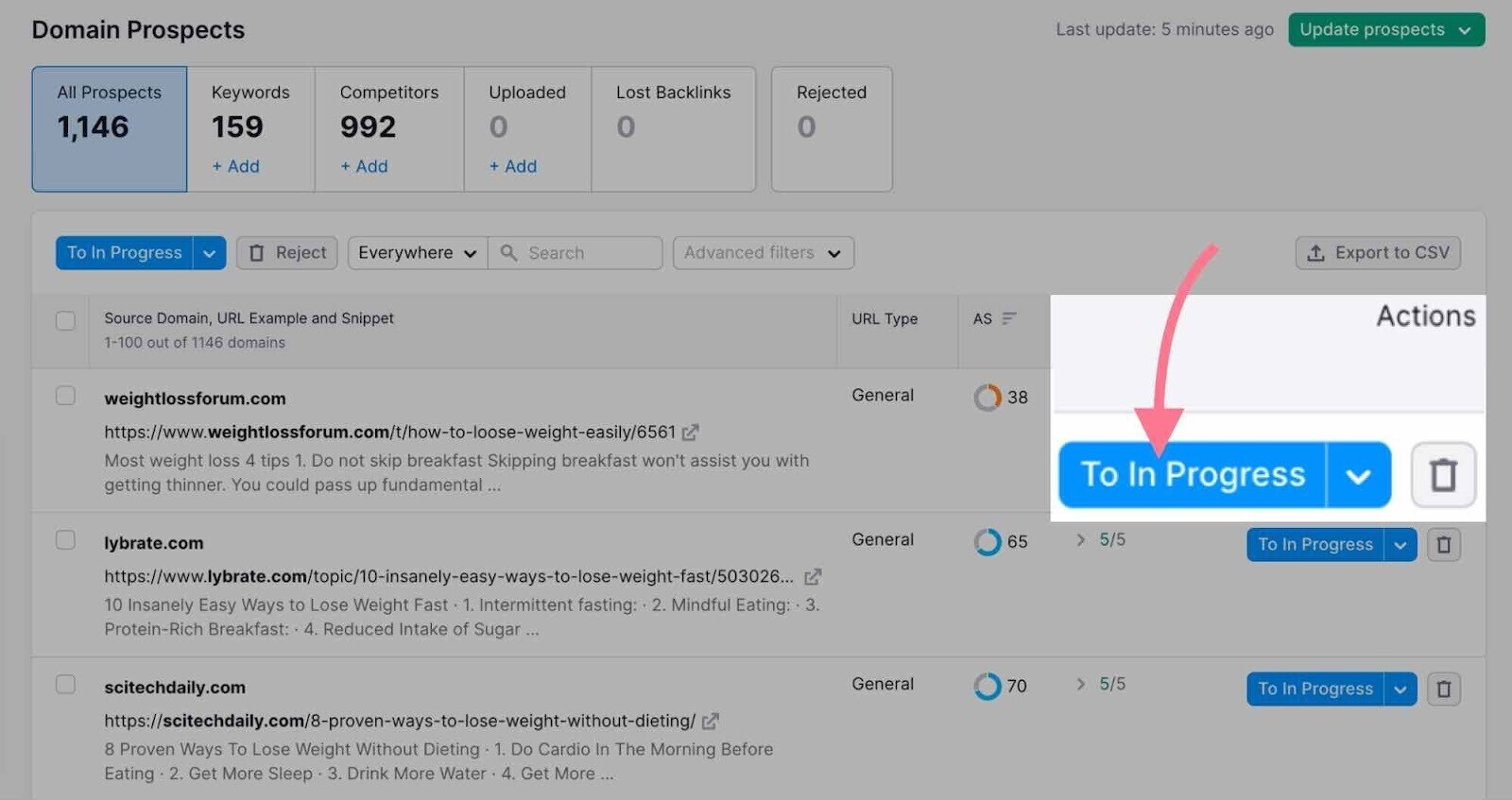
First, connect your email account by clicking the “Add” mailbox link. This way, you can reach out directly from the Link Building Tool.
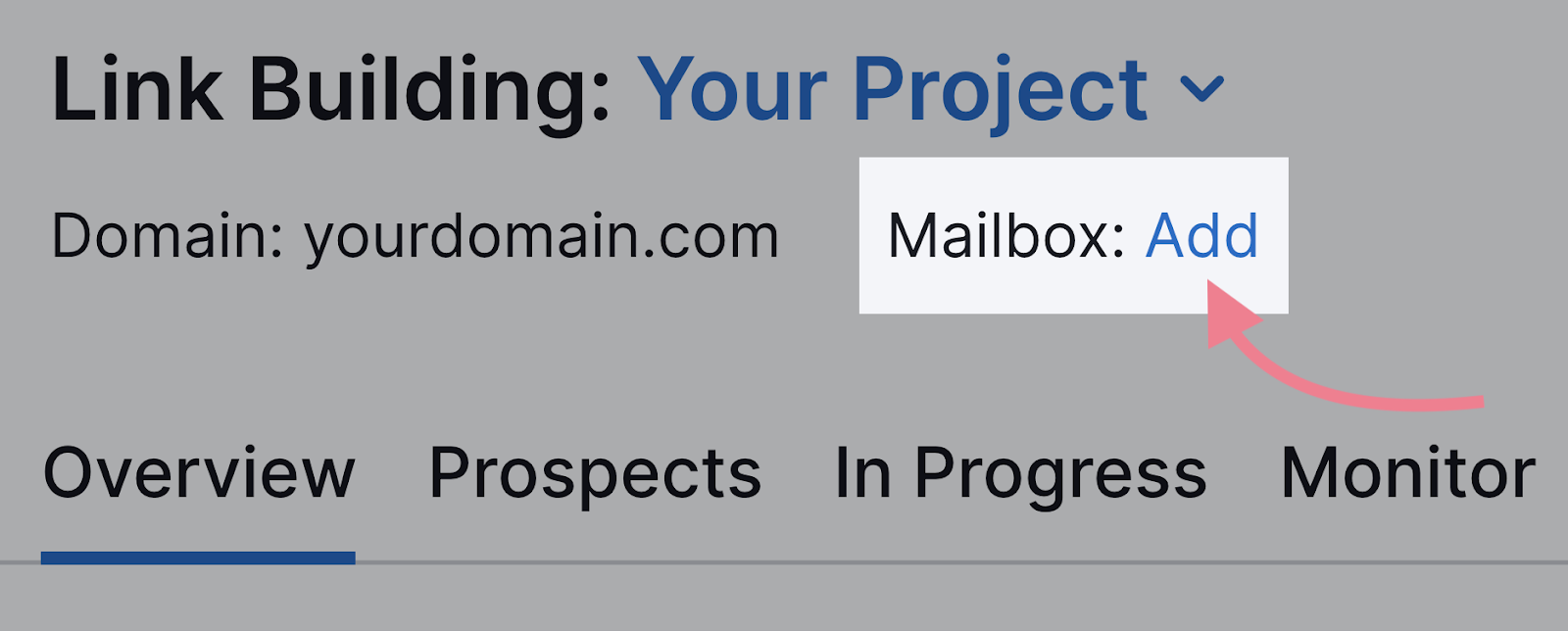
Then visit the “In Progress” tab.
Click “Contact” next to your prospect.
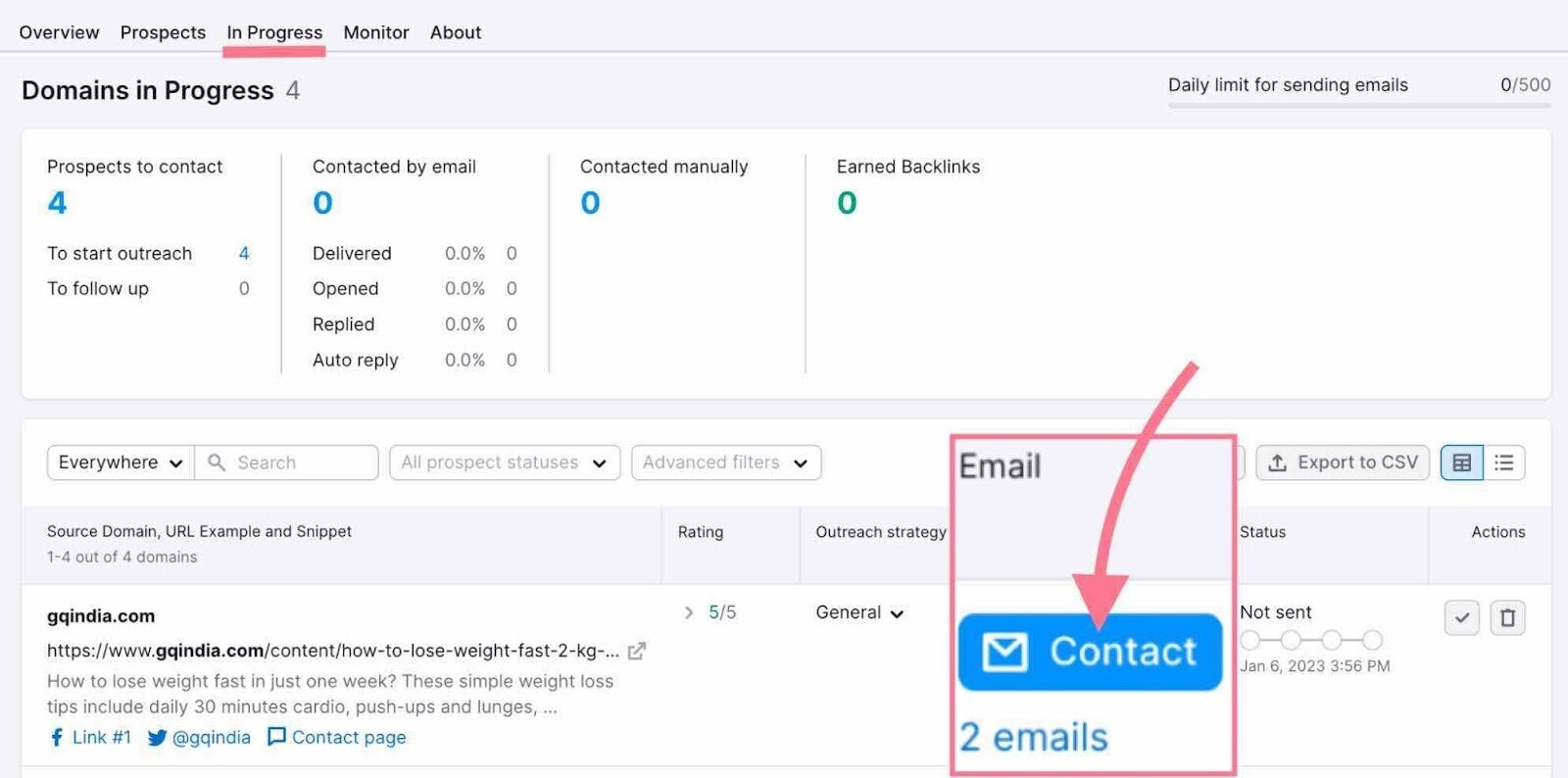
On the next screen, you’ll see an example outreach email.
Like this:
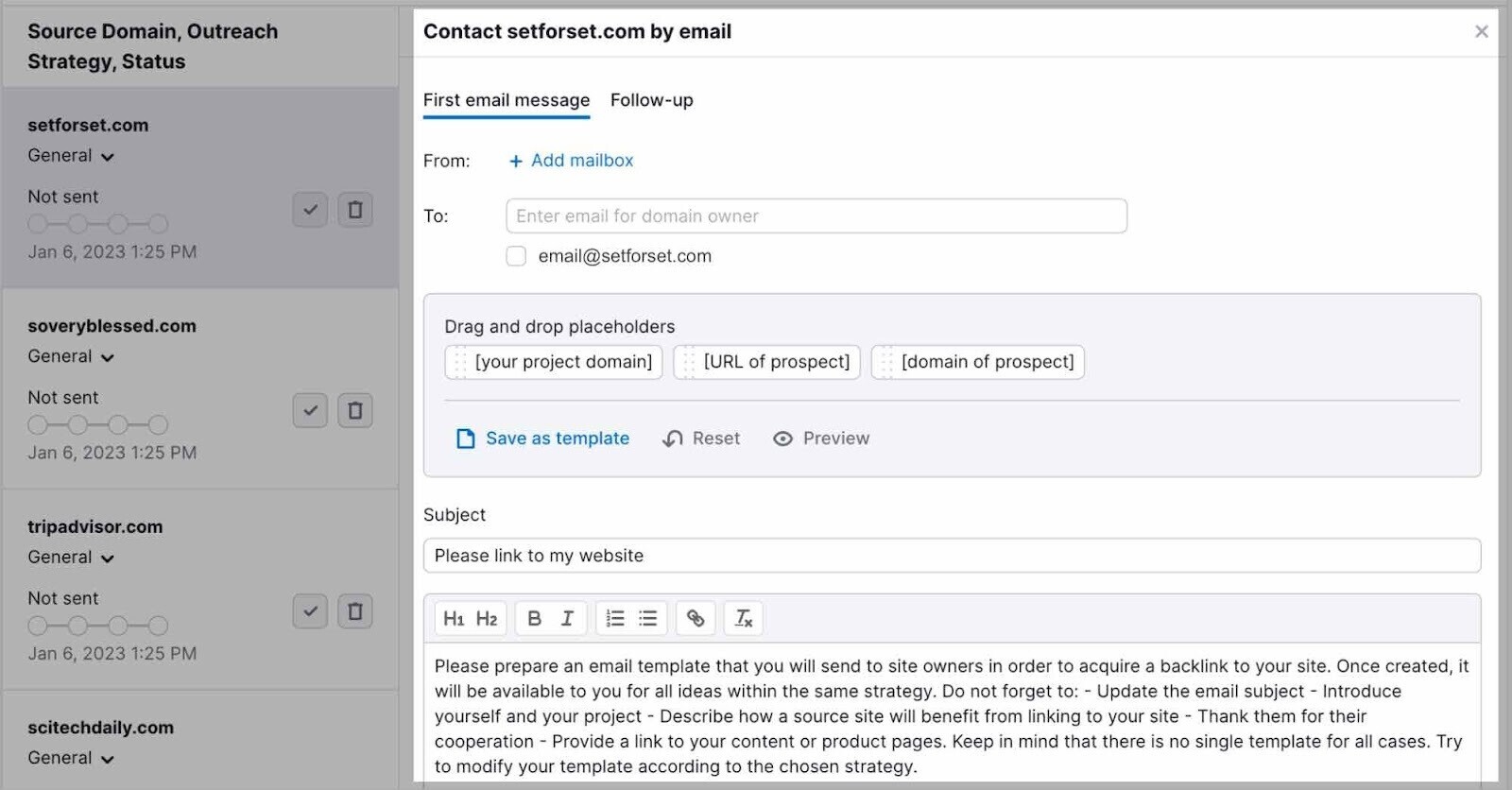
Fill out and personalize the template. And remember to provide a compelling reason your prospect should link to you.
Then send your email by clicking “Send and proceed to next.”
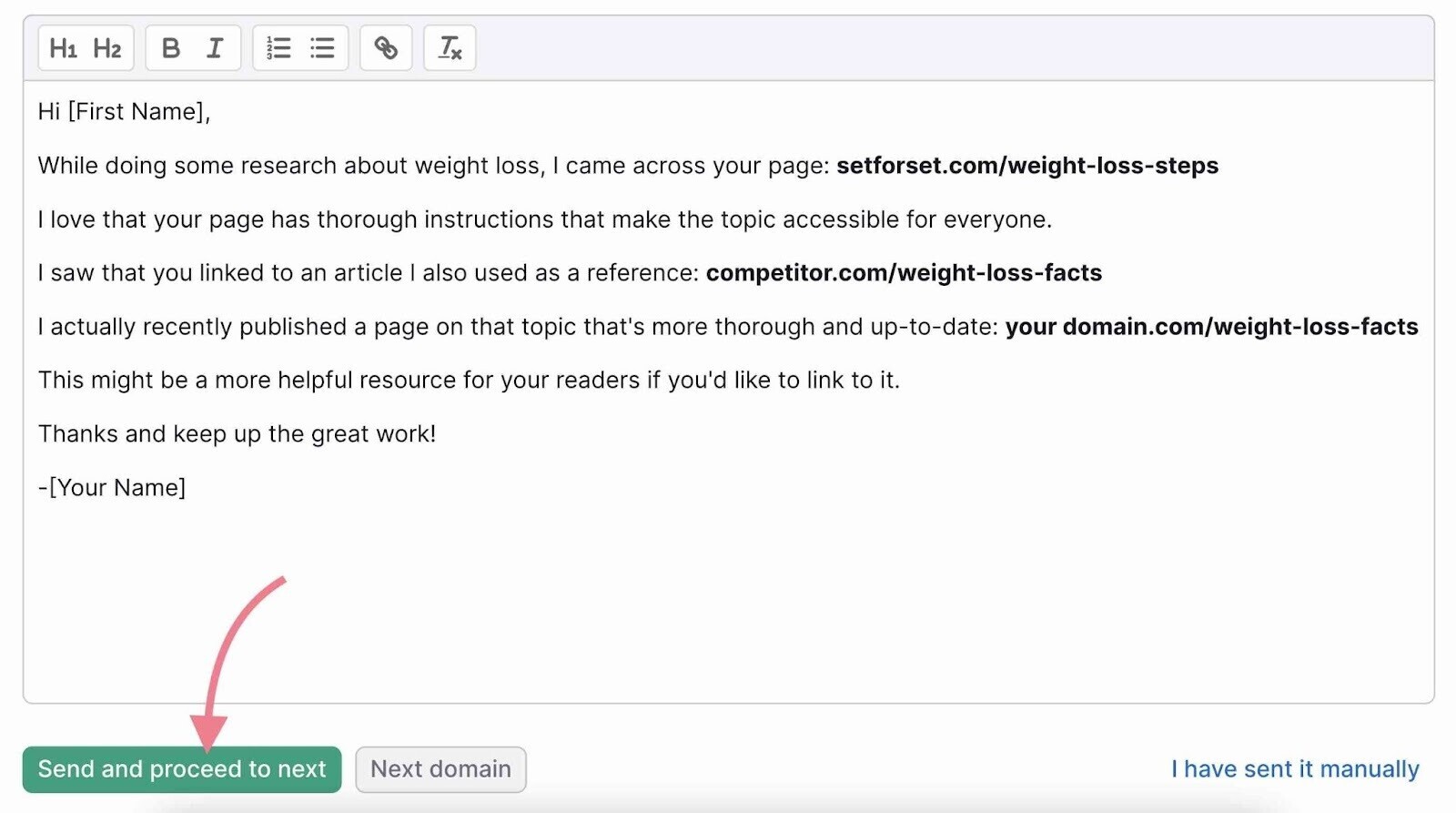
Once you’ve sent your outreach emails, go back to the ”In Progress“ tab and monitor your backlink prospects.
The “Status” column shows whether your emails were sent, opened, or replied to.
And shows “Backlink earned” status when your prospects finally link to you.

Plus, you can catch any lost backlinks by heading to the “Monitor” tab.

And scrolling down to toggle to “Lost” links. So you can focus your recovery efforts.

Pro tip: Use the Link Building Tool for any of the following tactics that require email outreach.
2. Broken Link Building
Broken link building involves finding broken external links on other websites and offering an alternative link from your own site.
This works because dead links contribute to poor user experience. So nobody wants them on their site.
Start by finding broken pages on your competitors’ websites with Semrush’s Backlink Analytics tool.
Type your competitor’s domain and click “Analyze.”
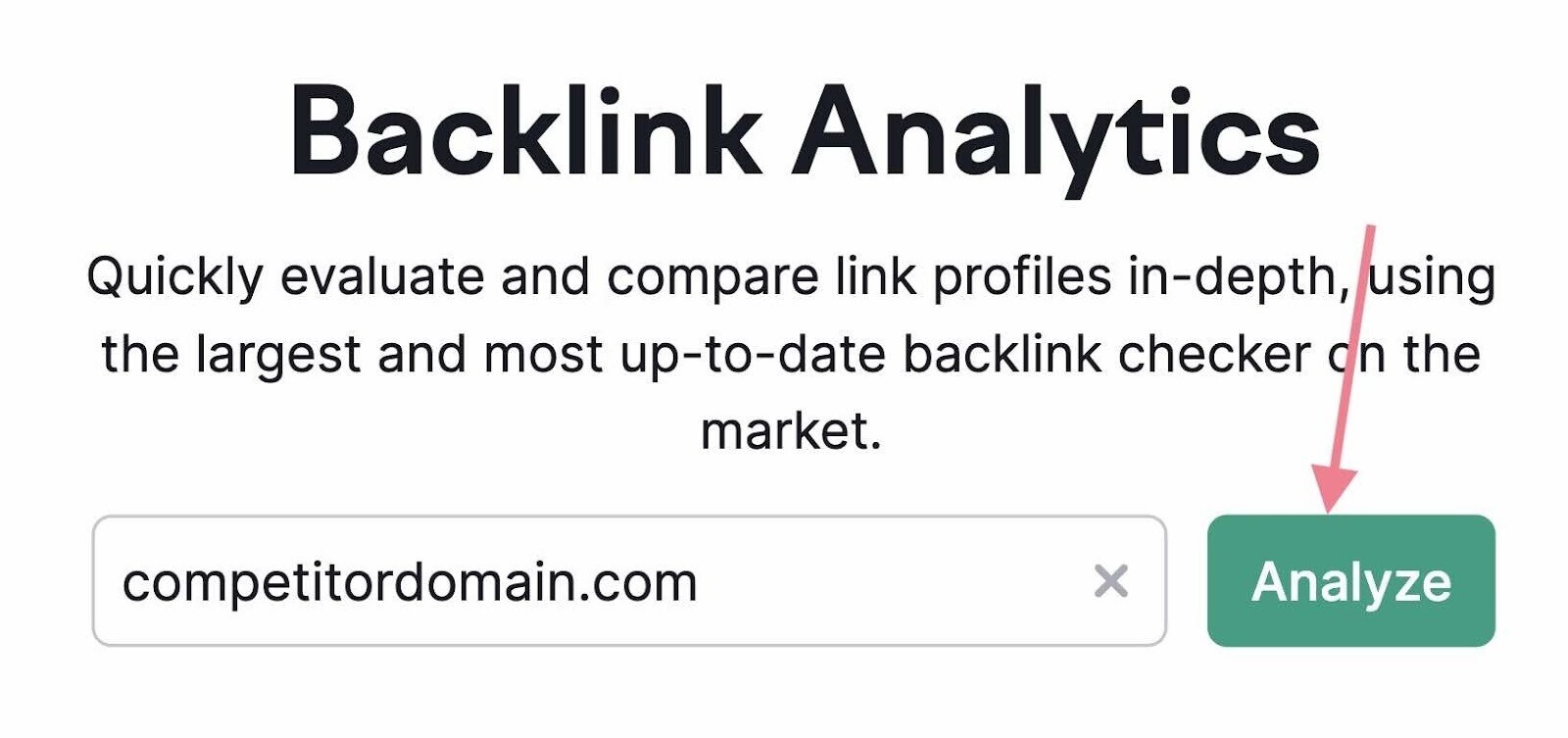
Next, navigate to the “Indexed Pages” report. Check the “Broken Pages” box.
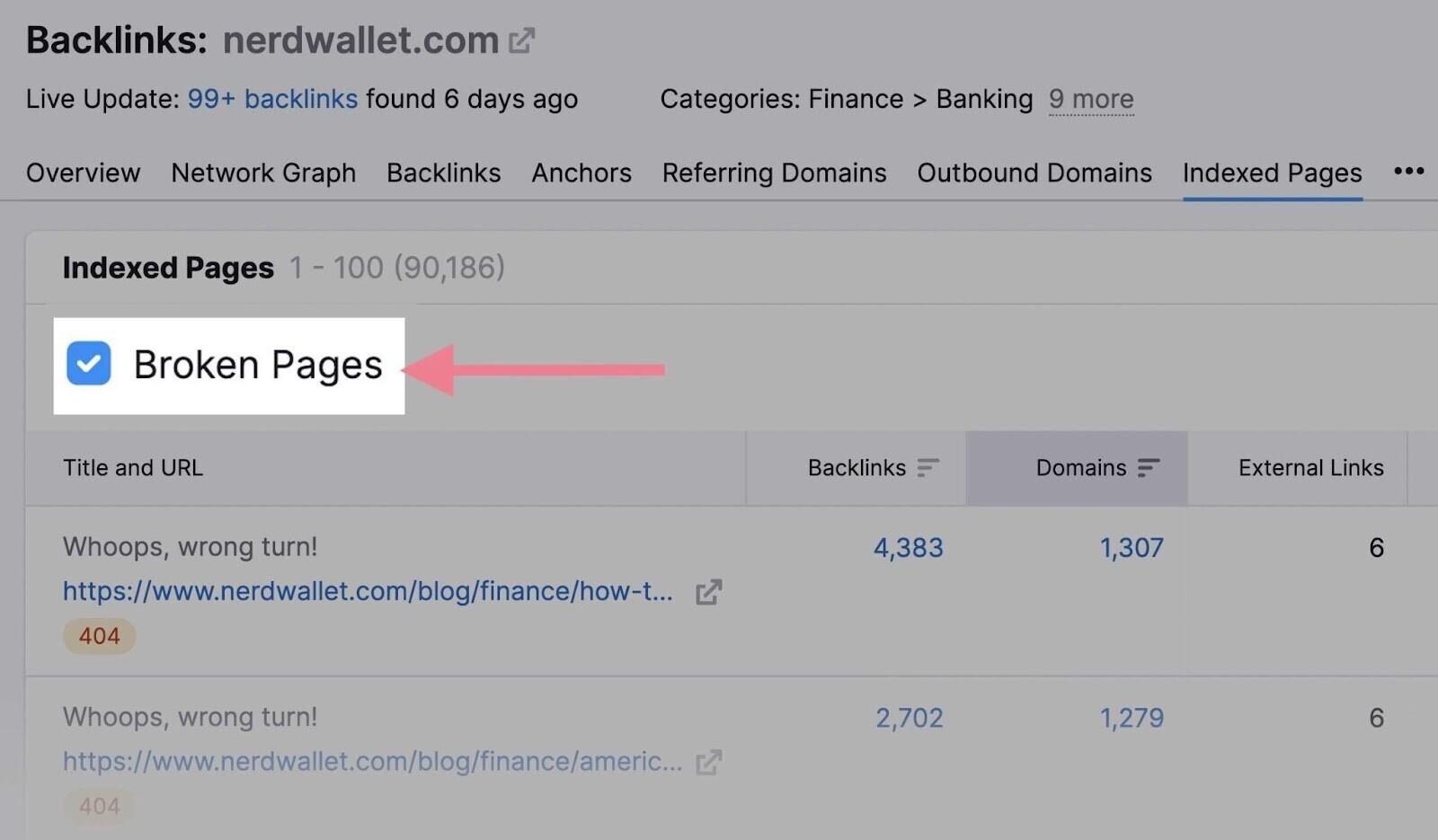
The tool will reveal your competitor’s broken pages. And how many backlinks each one has.
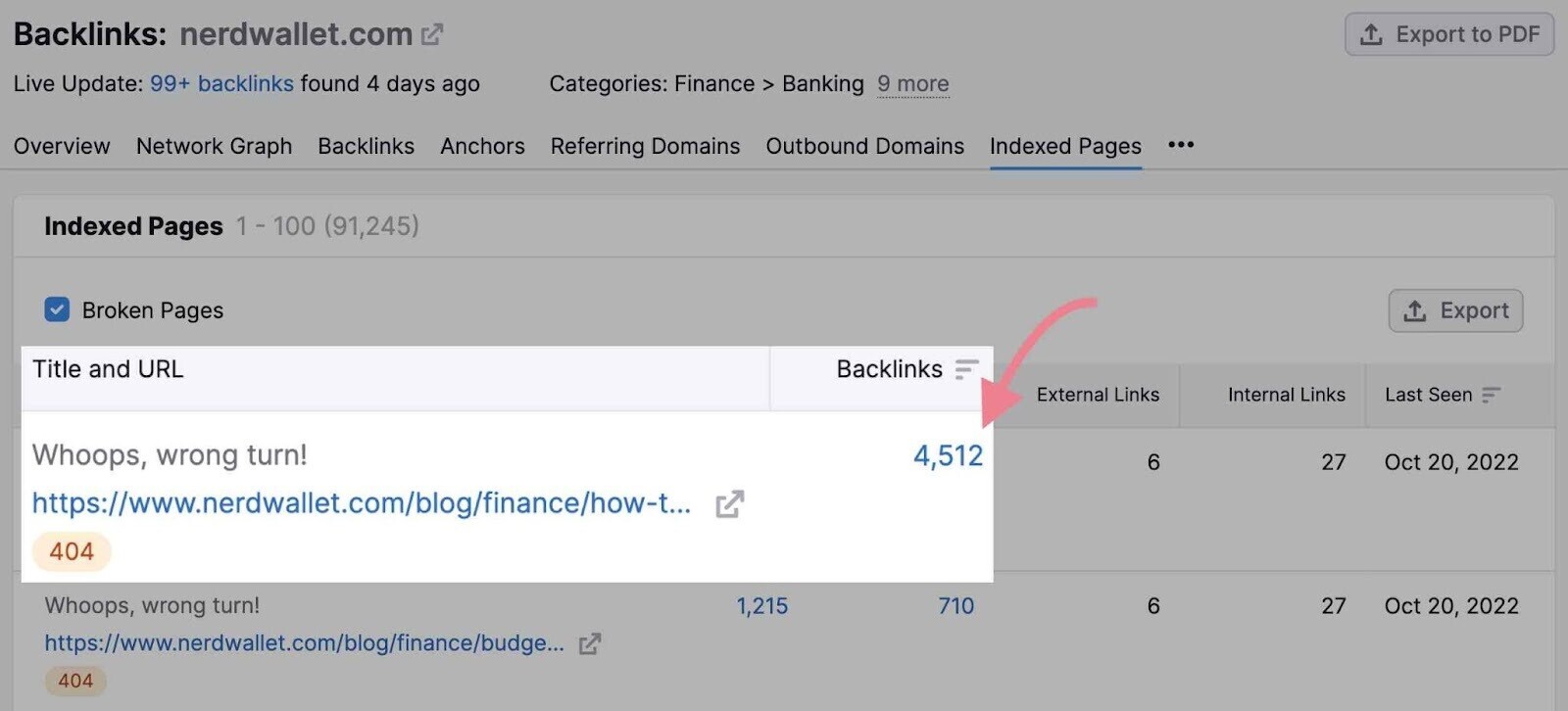
Analyze the broken pages’ URLs to determine what topics the content used to cover.
See if your site has similar content. If not, you can create a new page (as long as the topic is relevant to your website).
Then reach out to websites linking to broken pages and pitch your replacement link.
Click the number in the “Domains” column. These will be your potential prospects:
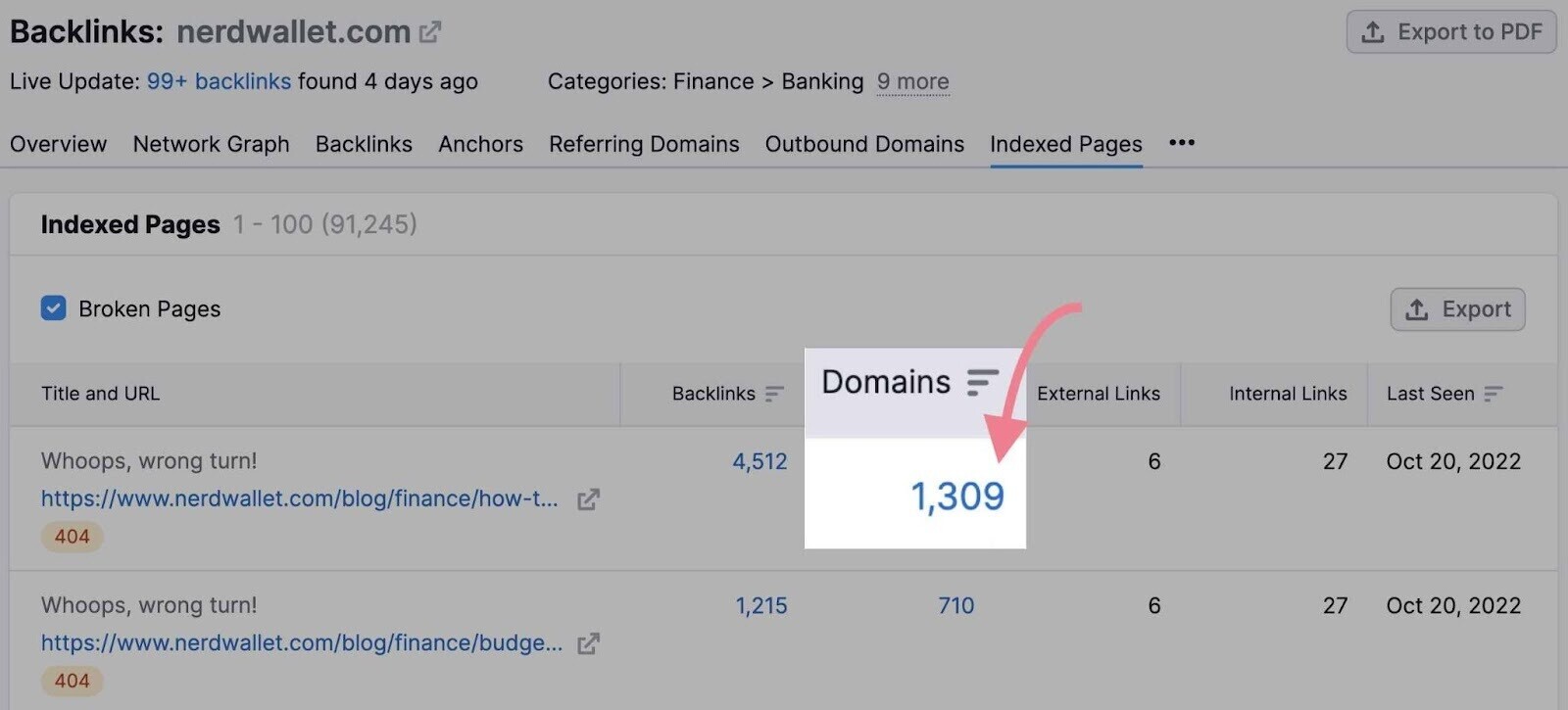
3. Unlinked Brand Mentions
Unlinked brand mentions are when websites mention your brand name without linking to your website.
Like this:
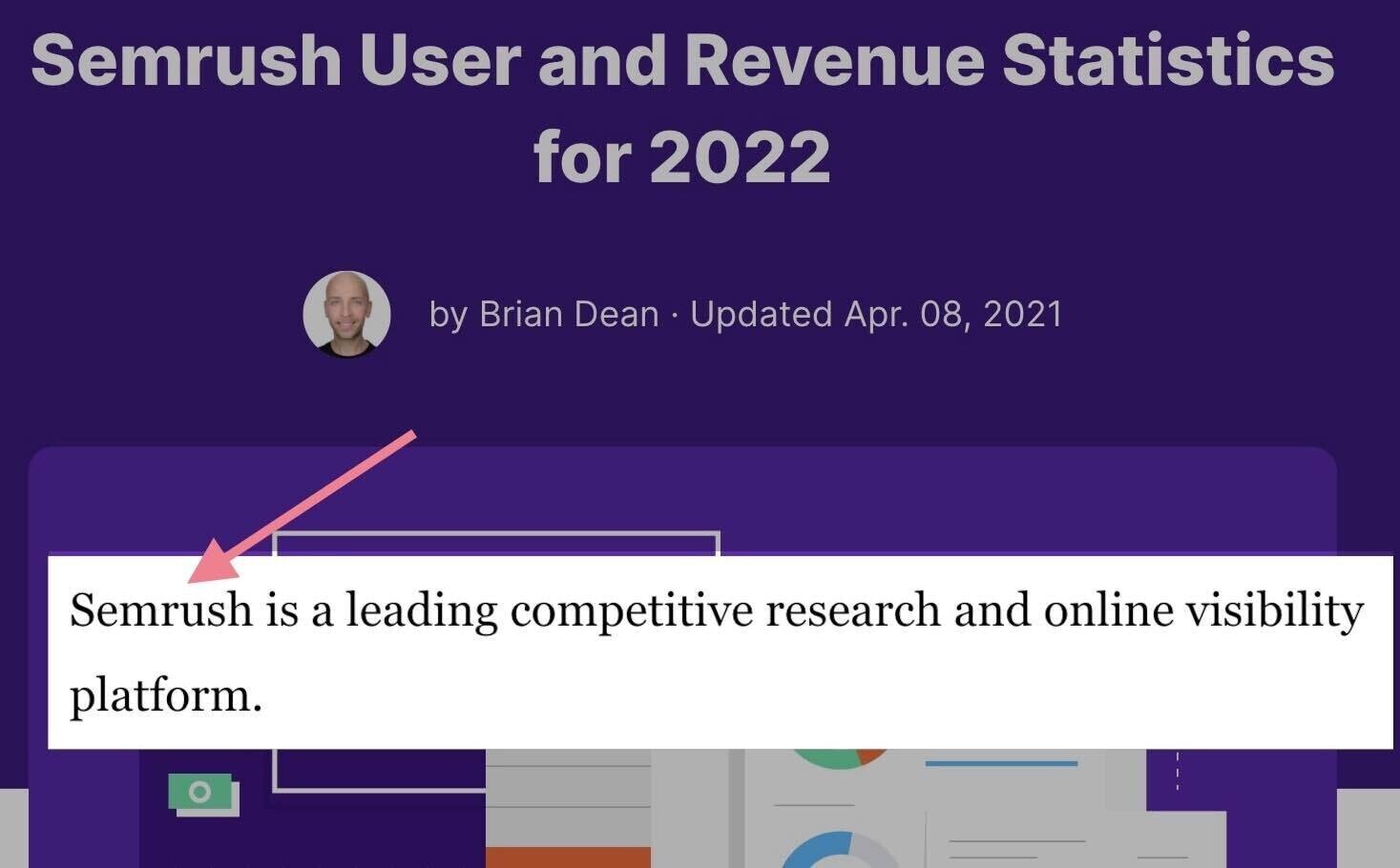
If websites mention you by name, they’re already familiar with your brand. So they may be more willing to add a link.
To find unlinked brand mentions, use the News Alerts app in Semrush.
Click “Get started” to begin.
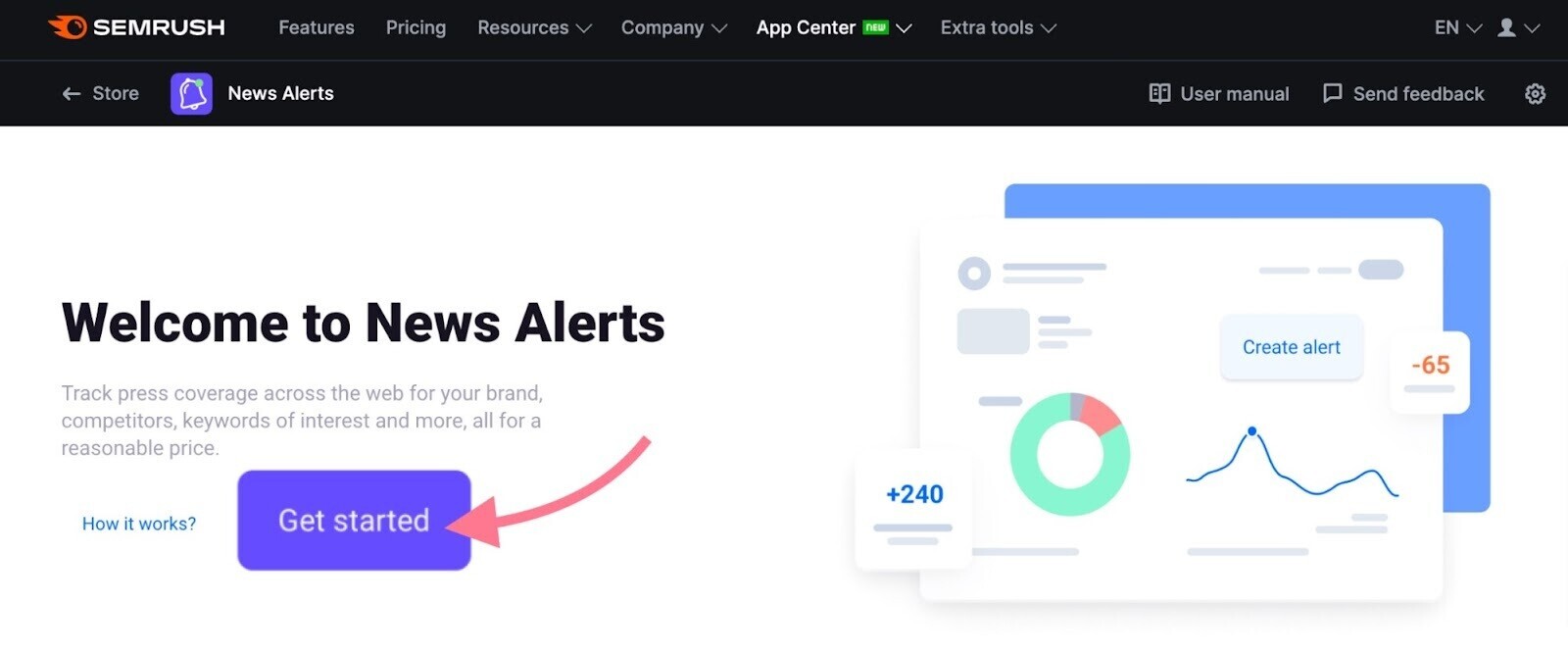
Click “New query.”
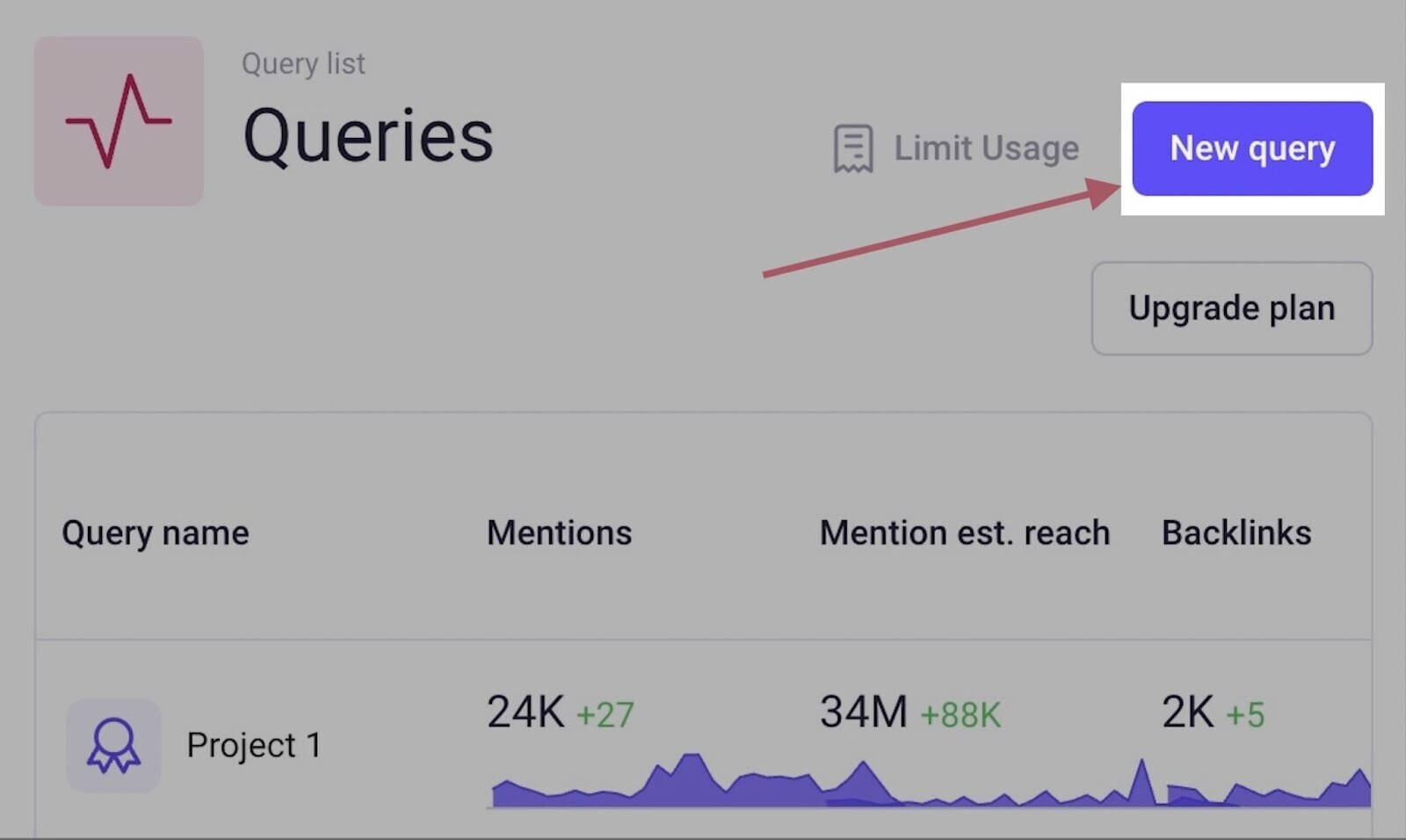
Click “Brand.”
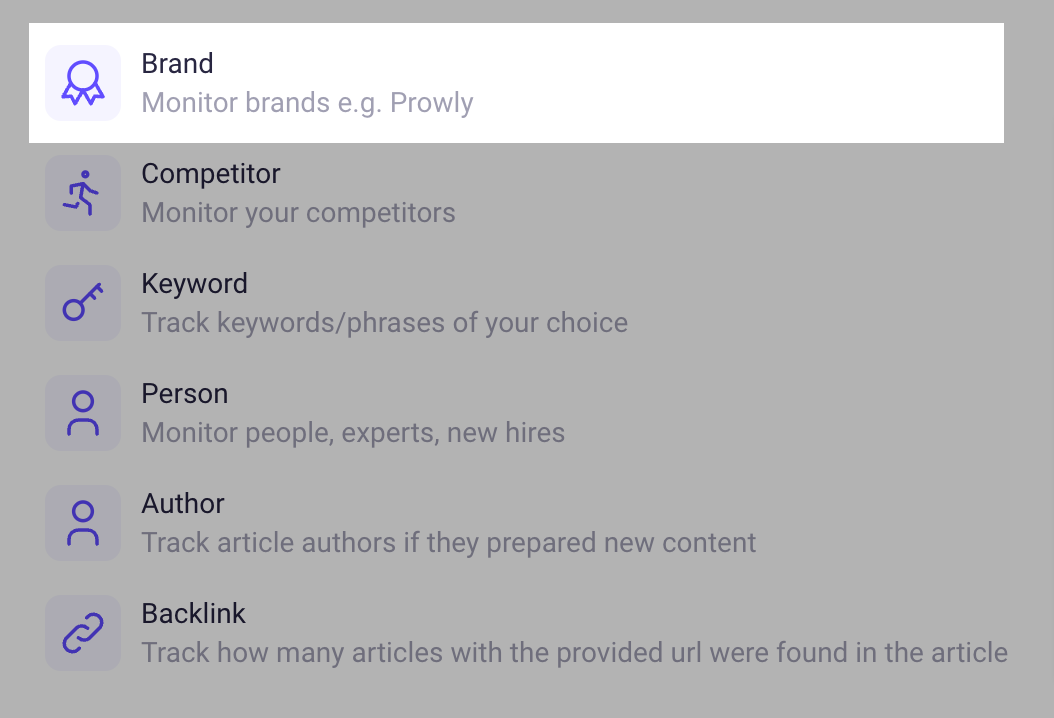
And enter your brand name.
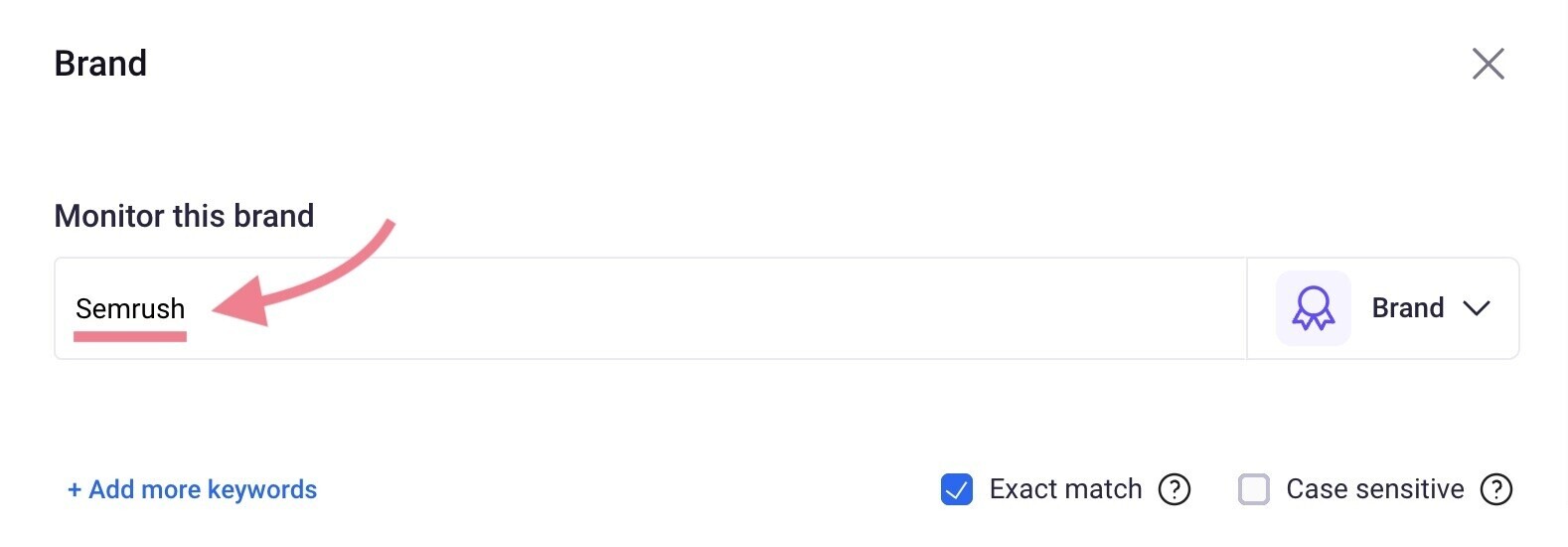
Next, select the type of alert you want to receive.
For unlinked brand mentions, select “New mention alert” from the drop-down.

Then enter your email. You can also choose to track backlinks from brand mentions.
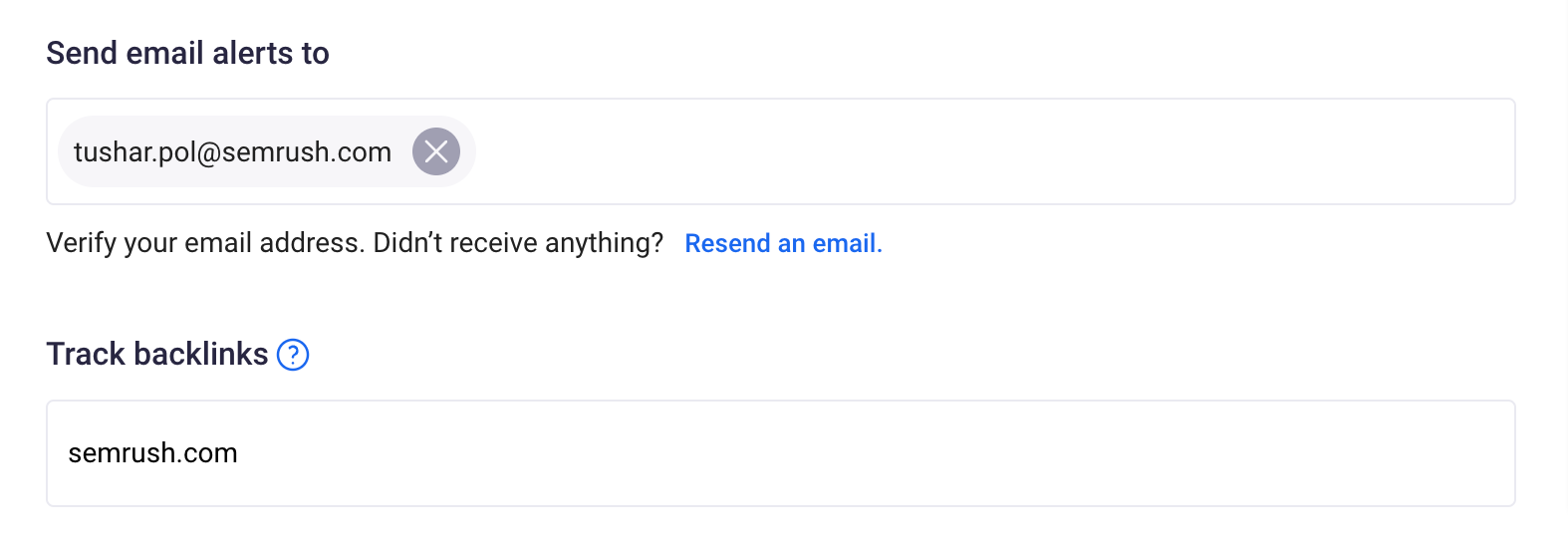
Finally, specify “Countries” and “Languages” to define the scope of your search.
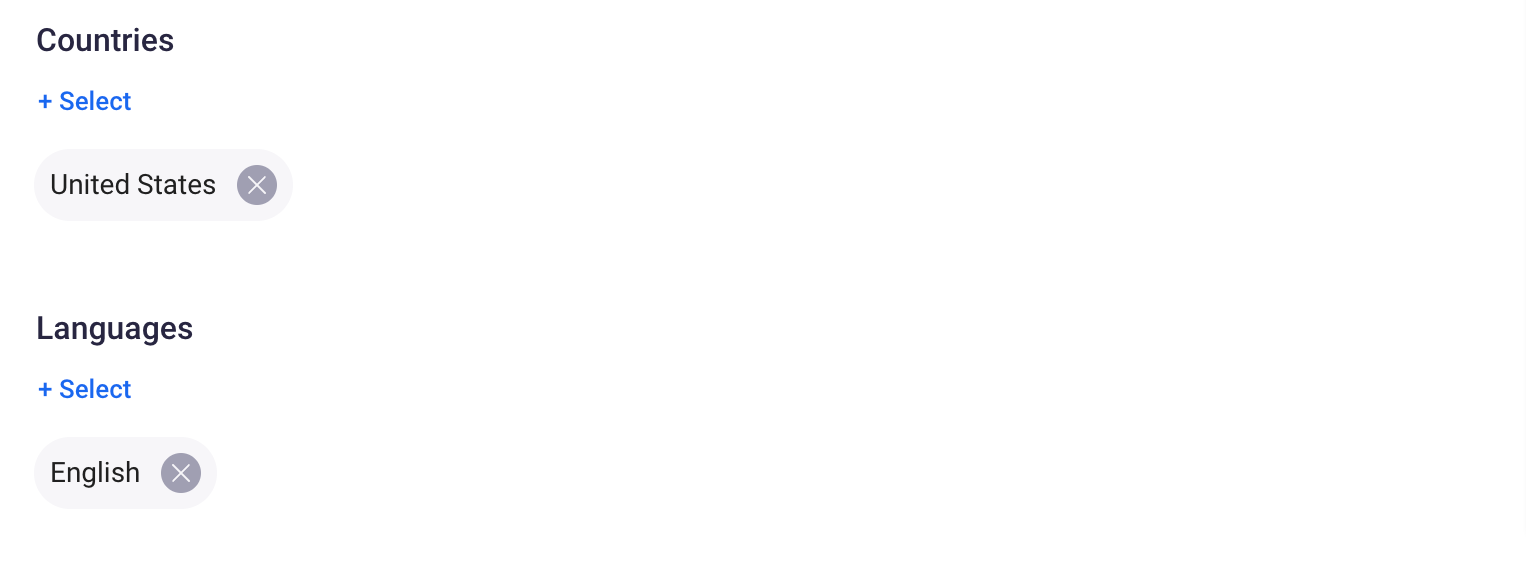
And click “Create query.”
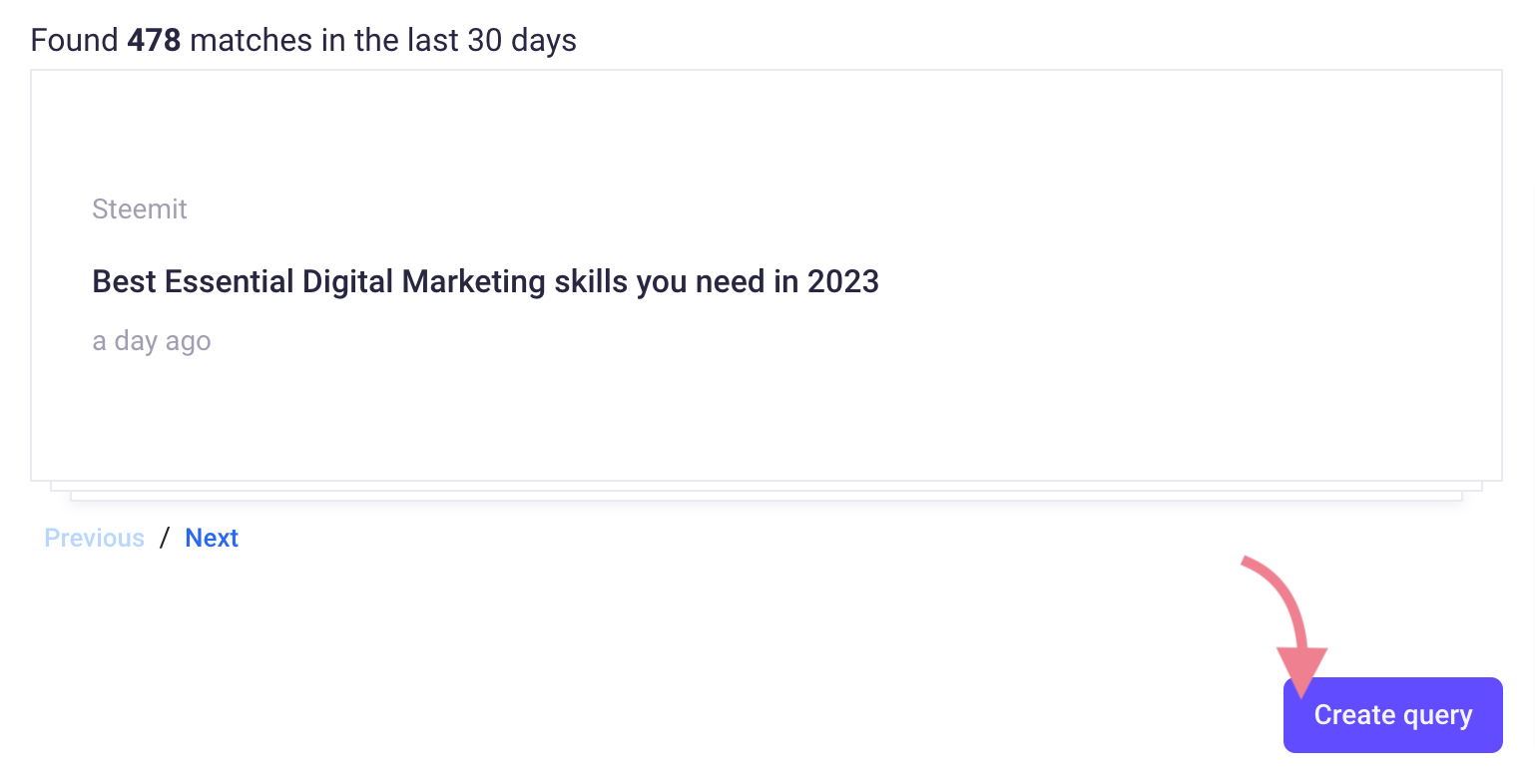
The tool will generate a list of webpages that mention your brand name—but don’t link to you.
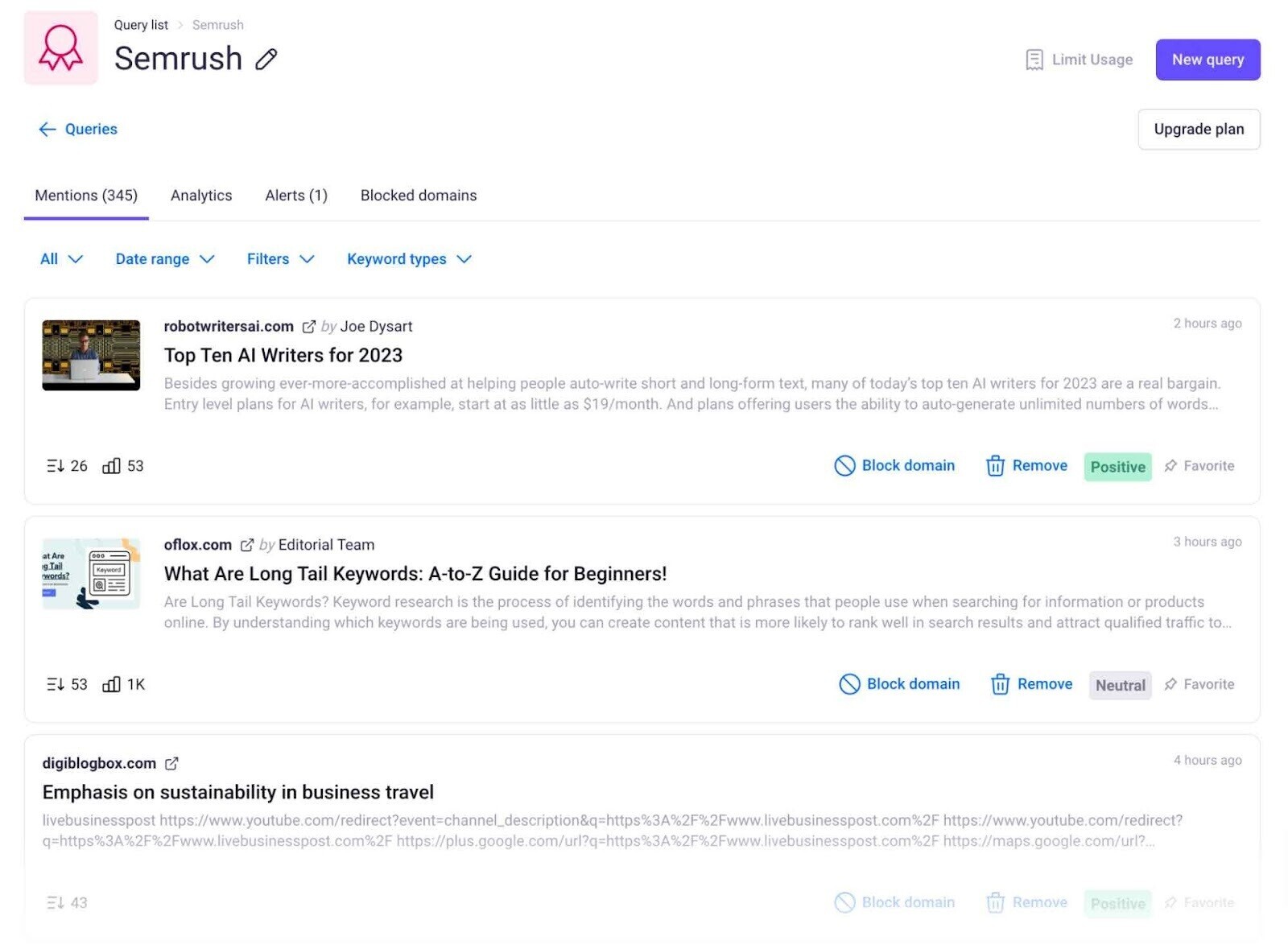
Analyze the results and reach out to sites you think would be a good match. Each one that agrees to “link” your unlinked brand mention on their site means you get another backlink.
Tip: You’ll probably be more successful with the results marked as “Positive.” This means the article’s sentiment is favorable toward your brand.
4. Competitor Backlink Analysis
Analyzing your competitors’ backlinks tells you which content types tend to attract the most backlinks in your industry.
Do your competitors earn backlinks on listicle posts? How-to guides? Opinion pieces? Or something else?
Use this information to create similar types of content for your website. And, ideally, earn backlinks.
To start, use Semrush’s Backlink Analytics tool.
Type a competitor’s domain and click “Analyze.”

You’ll see a detailed record of your competitor’s backlink profile—from referring domains to backlinks to an overall Authority Score.
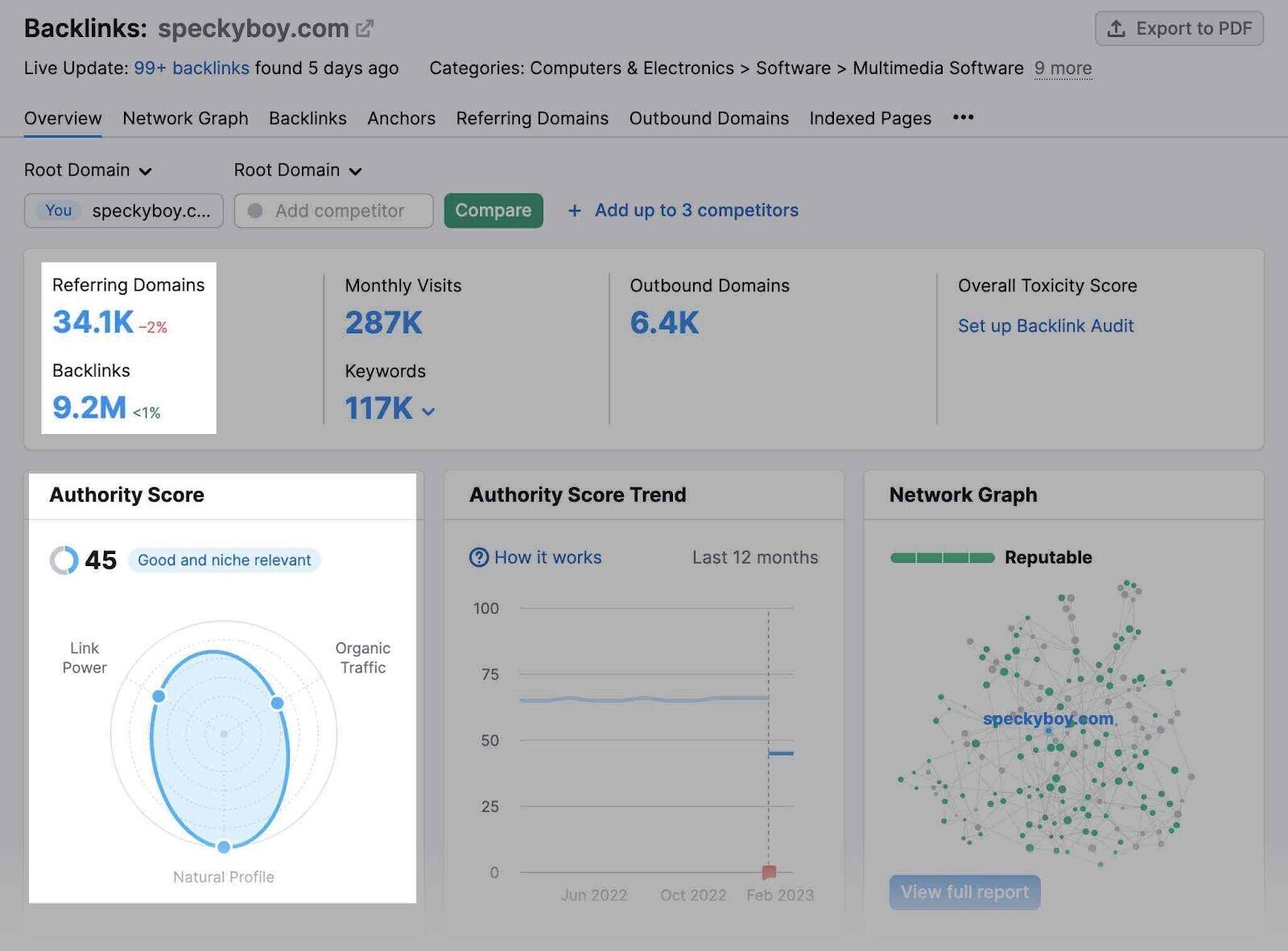
Navigate to the “Indexed Pages” tab.
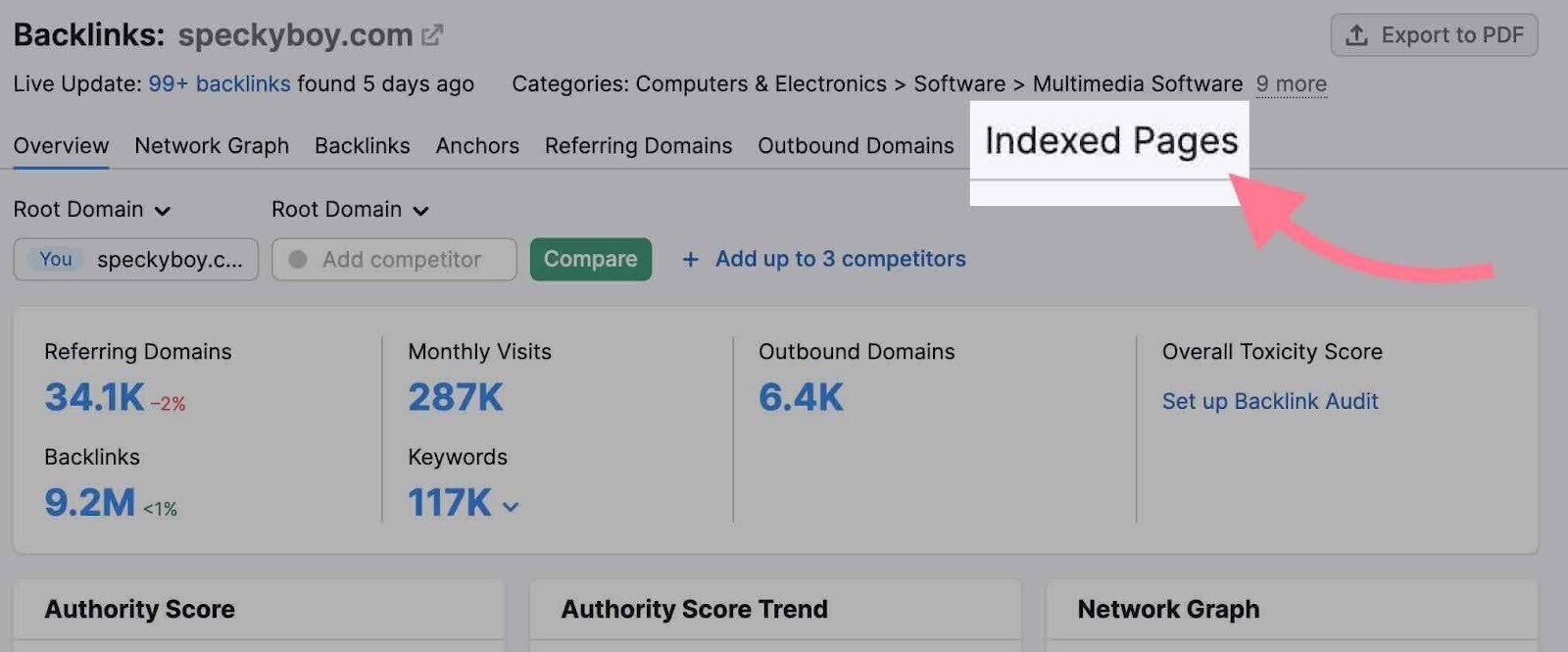
It shows your competitor’s pages sorted by the referring domains (i.e., the domains that link to your competitor’s site).
Below, we can see that many of speckyboy.com’s most linked-to pages are listicle posts:
- “10 Open-Source Login Page Templates Built With HTML & CMS”
- “50+ Web & Mobile UI Free Figma Templates”
- “The 100 Best Free Fonts for 2023”
- And so on
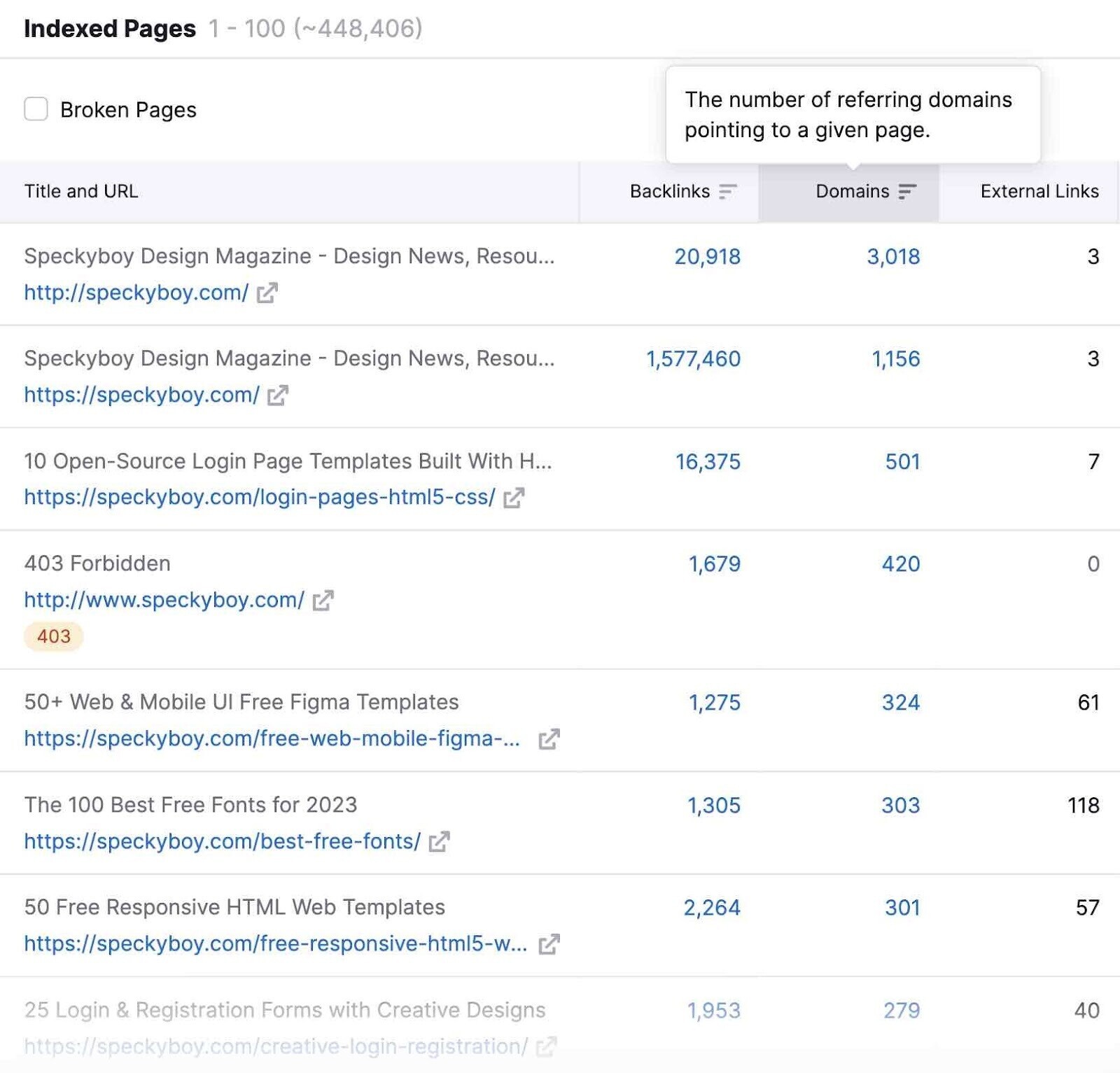
If you’re in the same industry, consider experimenting with list-style posts for your website.
Repeat this process for other competitors and jot down topic ideas. After you create new content, refer to the Link Building Tool outreach process as needed.
5. HARO
Using HARO (Help a Reporter Out) is another way to build high-quality backlinks to your site.
HARO connects journalists with industry experts. Because journalists often need an expert’s opinion for their articles.
And if they cite you, there’s a good chance they’ll link to your website.
Authoritative media outlets like The New York Times, The Wall Street Journal, Mashable, and TIME all use HARO.
So you have a chance to receive backlinks from reputable publications.
Go to HARO’s website to sign up and register as a source.

Then go to “My Account.”
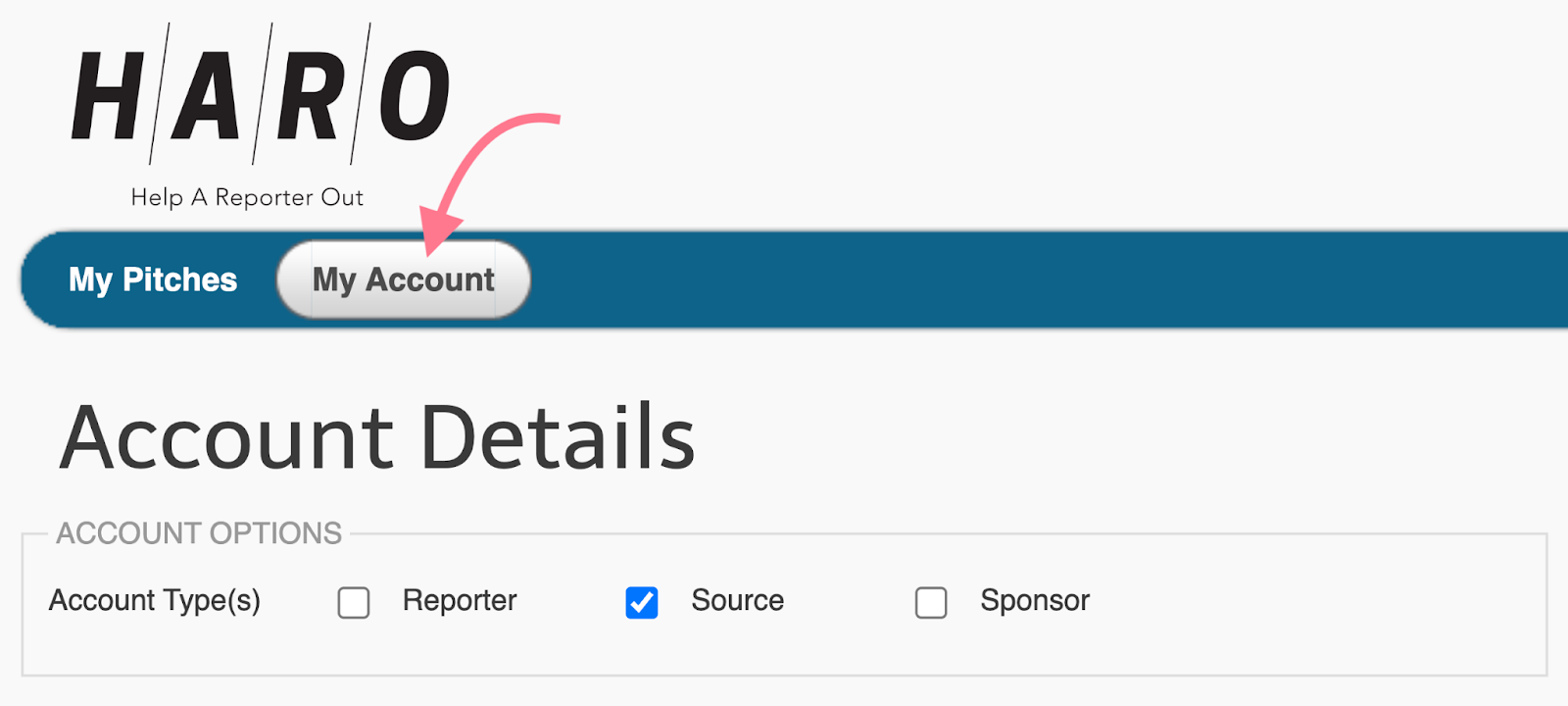
Under “HARO PREFERENCES,” you’ll see that HARO categorizes requests by industry.
Subscribe to the ones that make sense for your business.
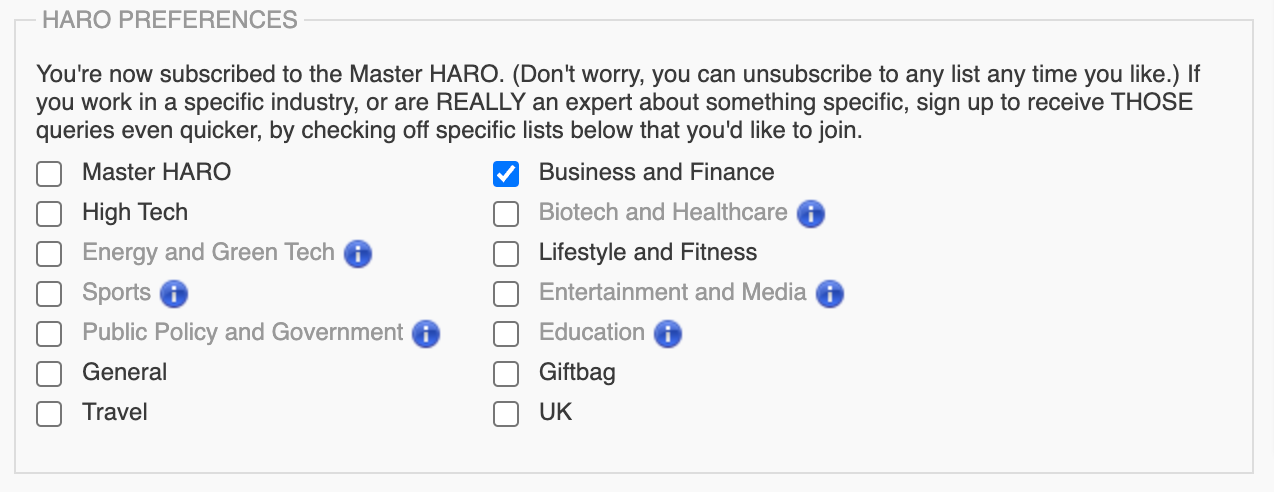
Now, you’ll receive emails with journalist queries.
Here’s an example:
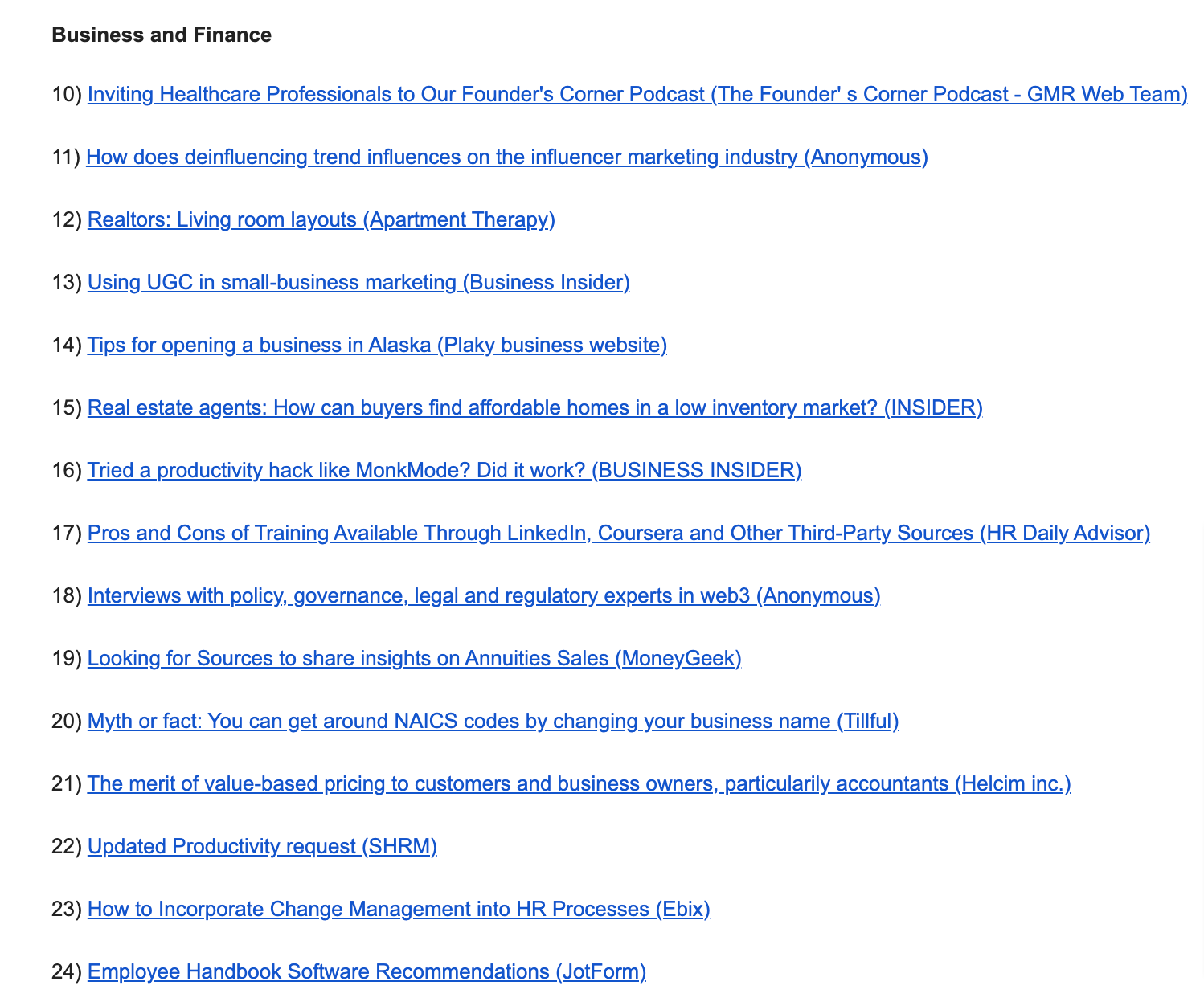
Each query has a title and the name of the media outlet in brackets.
If you see a relevant query, click on it to get detailed information.
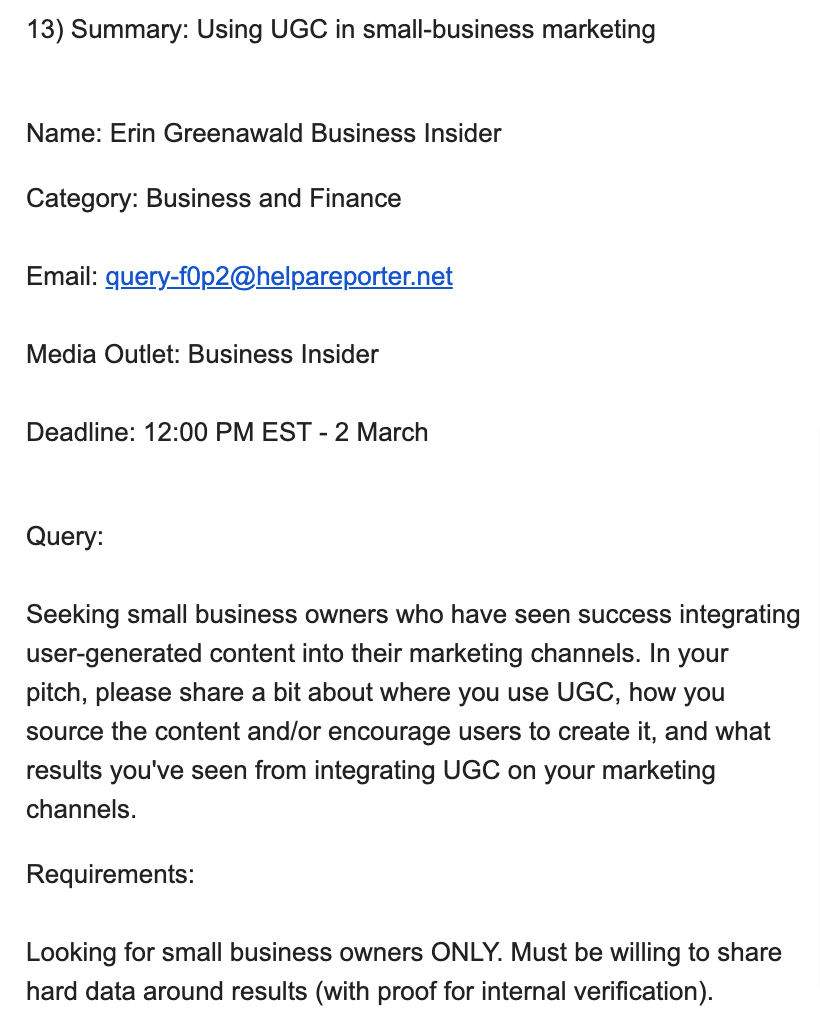
Then respond to the request by making a solid contribution.
This means adding value by thoroughly answering all the questions in the query.
We also recommend including your contact information and a link to your website. This way, journalists can contact you for follow-up questions. And they’ll know which link to use if they cite you.
6. Digital PR
Digital PR is a strategy used to increase online brand awareness via digital methods.
It’s a broad field that encompasses some of the other link building strategies we discuss in this list, such as HARO and creating linkable assets.
Other examples of digital PR include the following:
- Sharing press releases about your company with journalists
- Building relationships with bloggers or online journalists
- Participating in influencer marketing
Digital PR and link building go hand in hand.
Let’s say something newsworthy happens at your company. And you want journalists to cover the story.
Write a press release about it and reach out to journalists at relevant media publications.
If journalists decide to cover your story, they’ll usually link to your site when they mention your brand.
Find journalist contacts with a digital PR tool like Prowly.
After you sign up, click “Database” from the navigation sidebar.
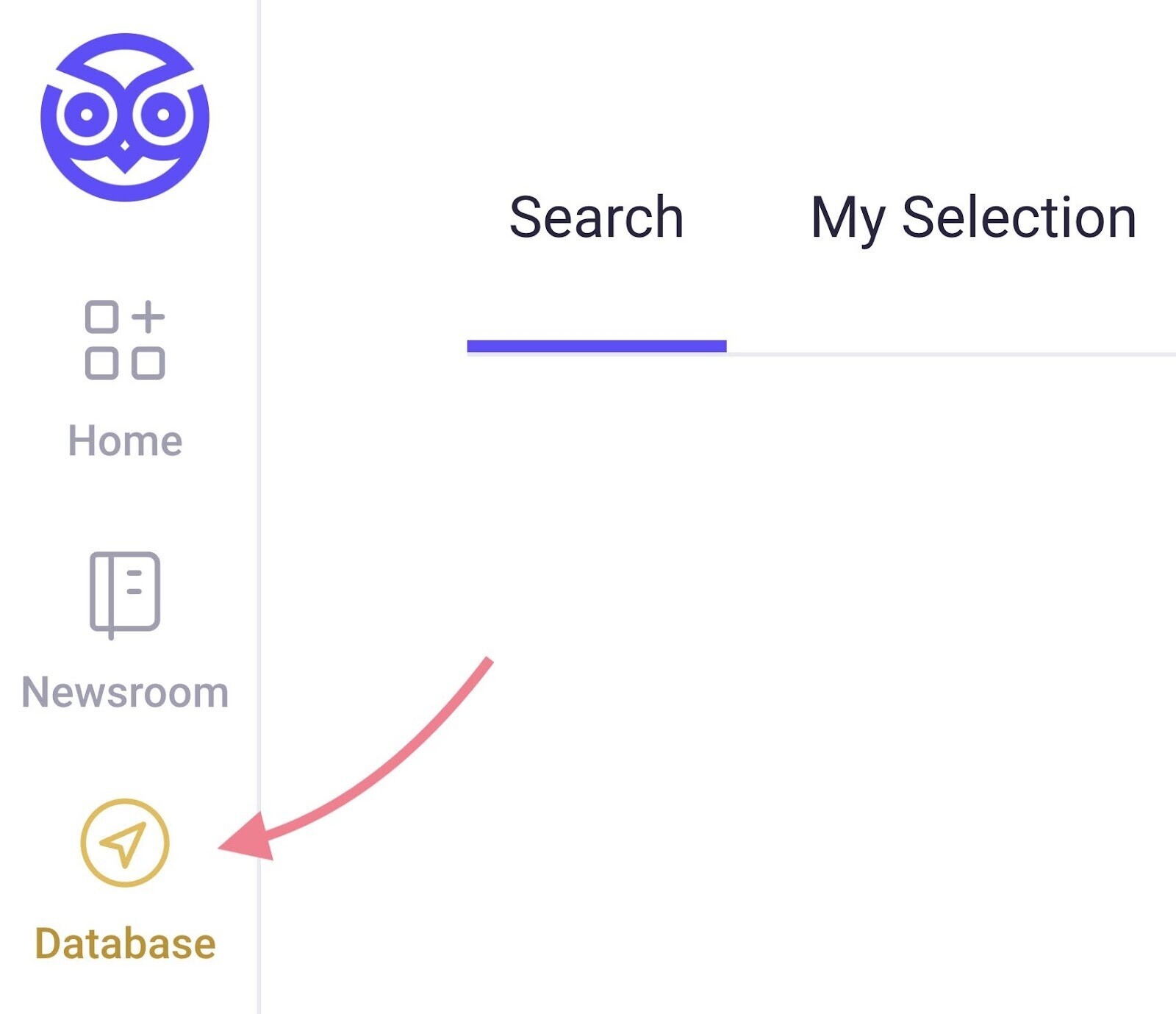
You now have access to Prowly’s media database. Which includes the contact information for journalists from various industries.
Search by people, media outlets, or keywords. And select your preferred country.
Then hit “Search.”
For this example, we searched by “Media outlet” and selected the United States as a preferred country.
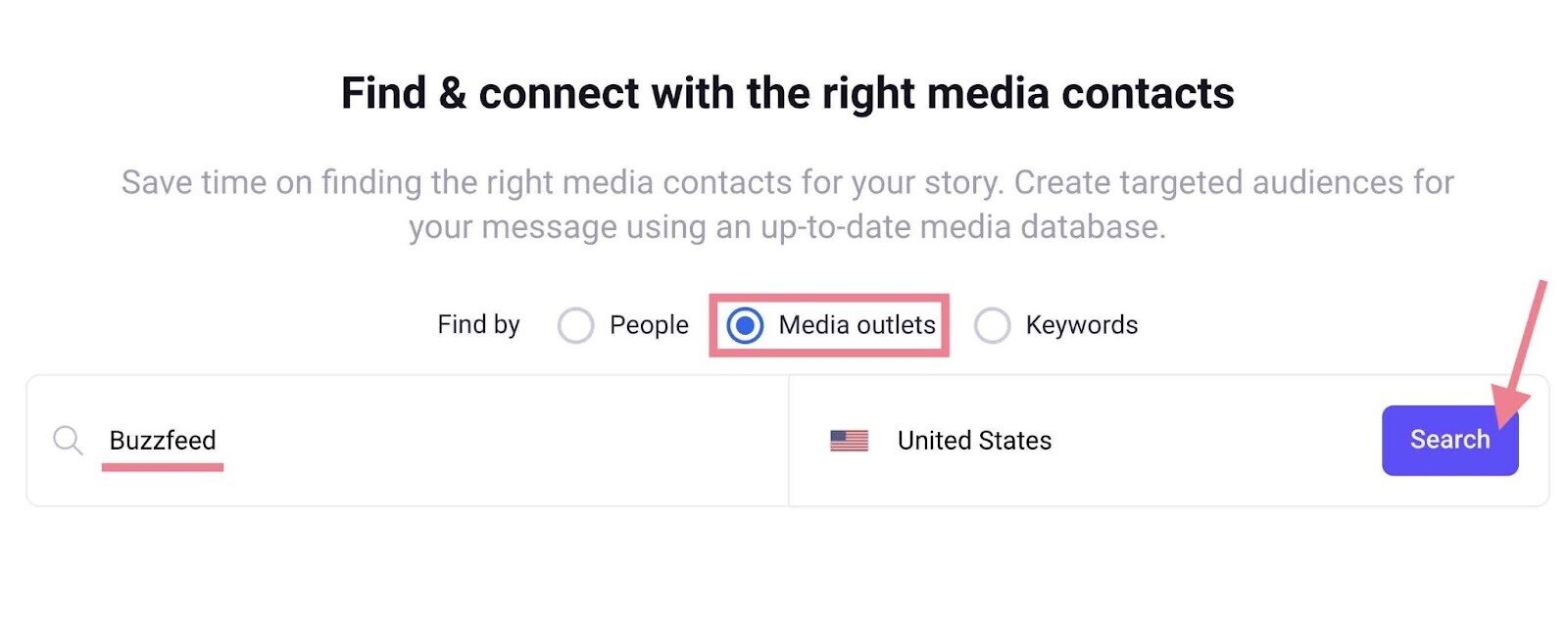
The tool will show media outlets related to your search.
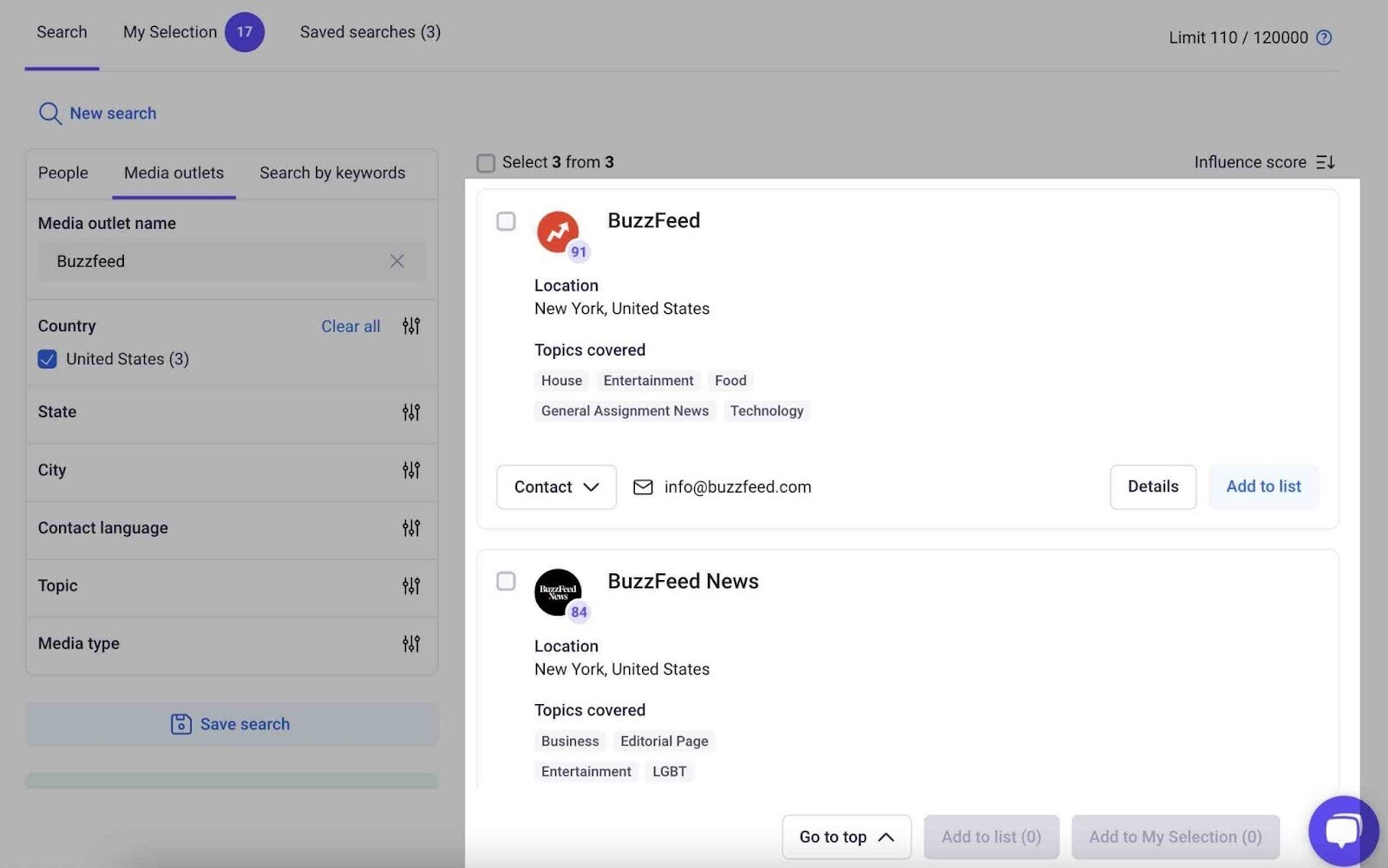
Once you click on a media outlet, you’ll see relevant writers, editors, or reporters you can contact about your story.
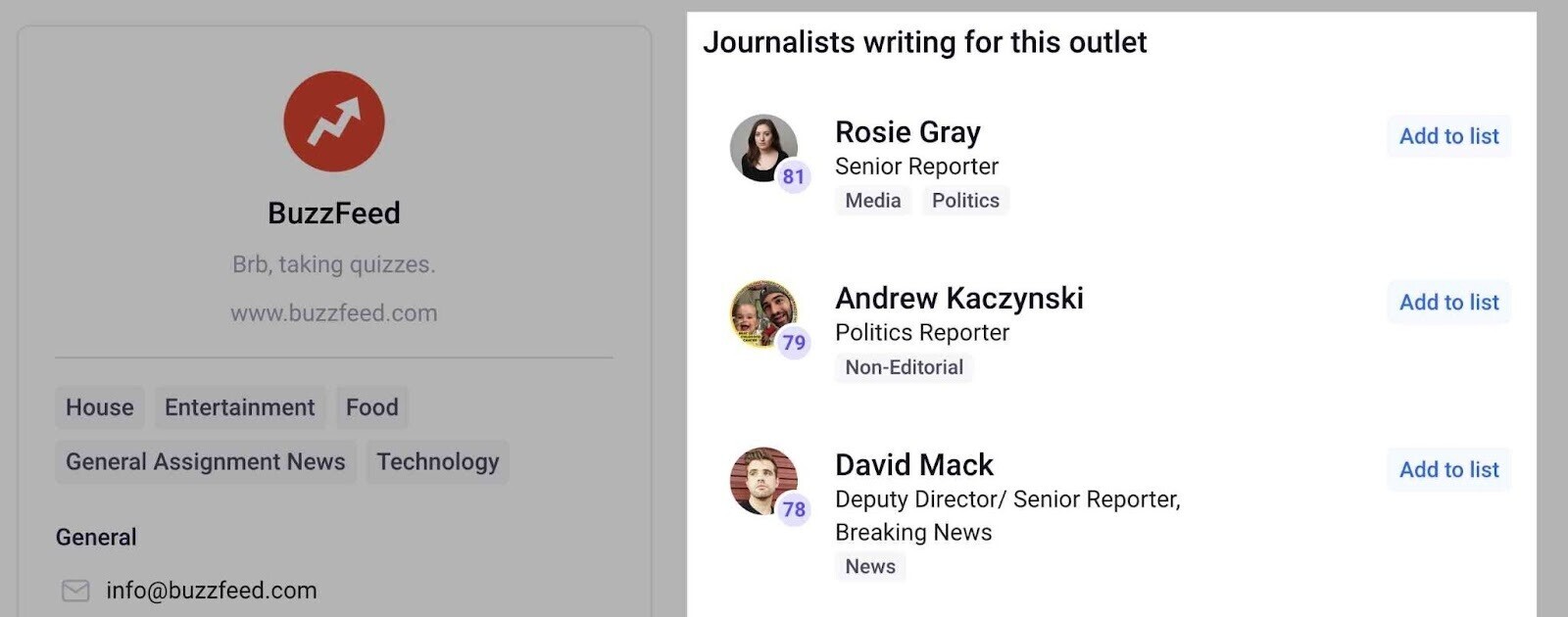
To get in touch with a media person, click their name to see their information.
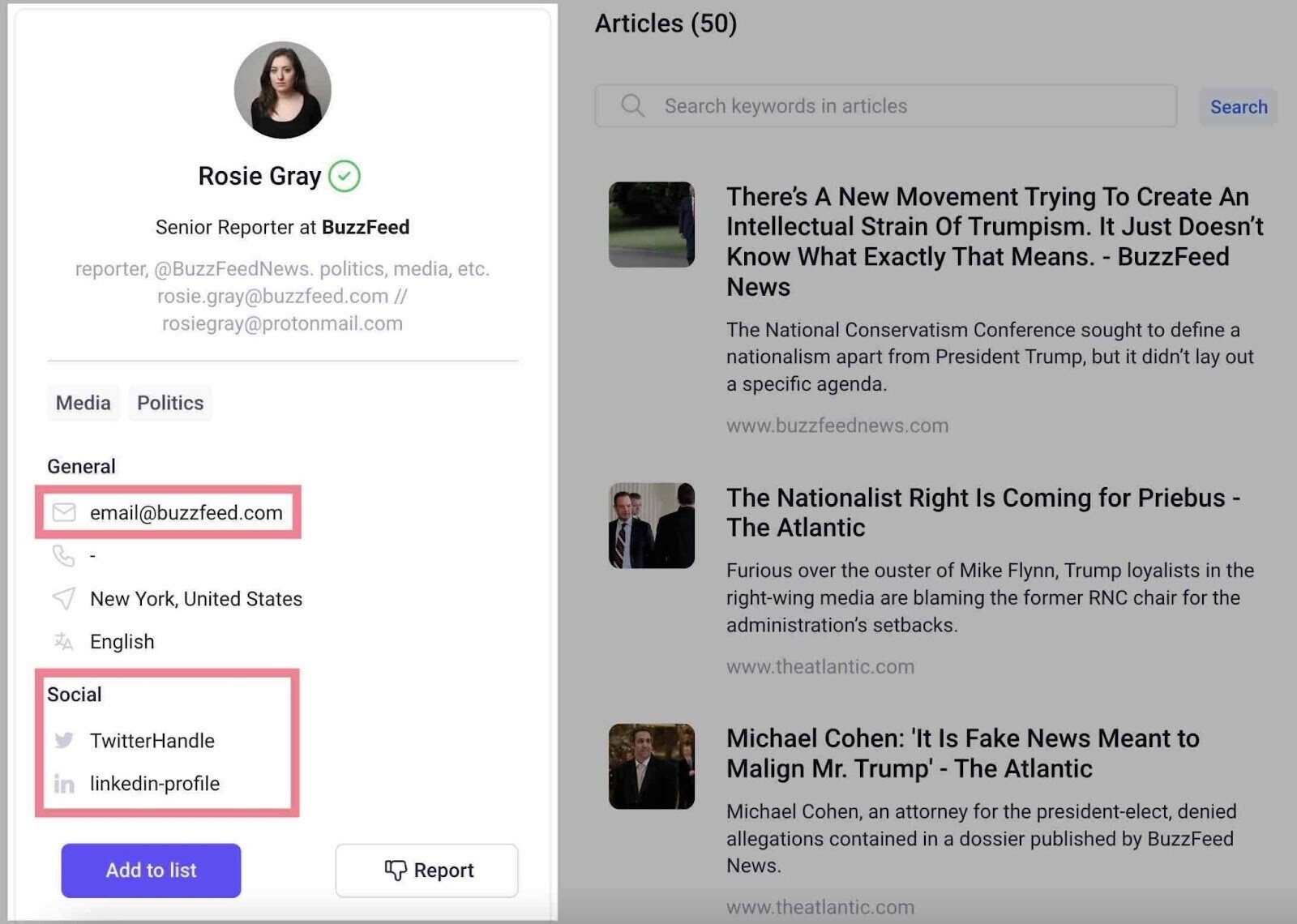
You can also add the media contacts to a list. Where you can return to review them later on.

Finally, pitch your story to them.
In Prowly, click on the “Emails” tab and create a “New email.”
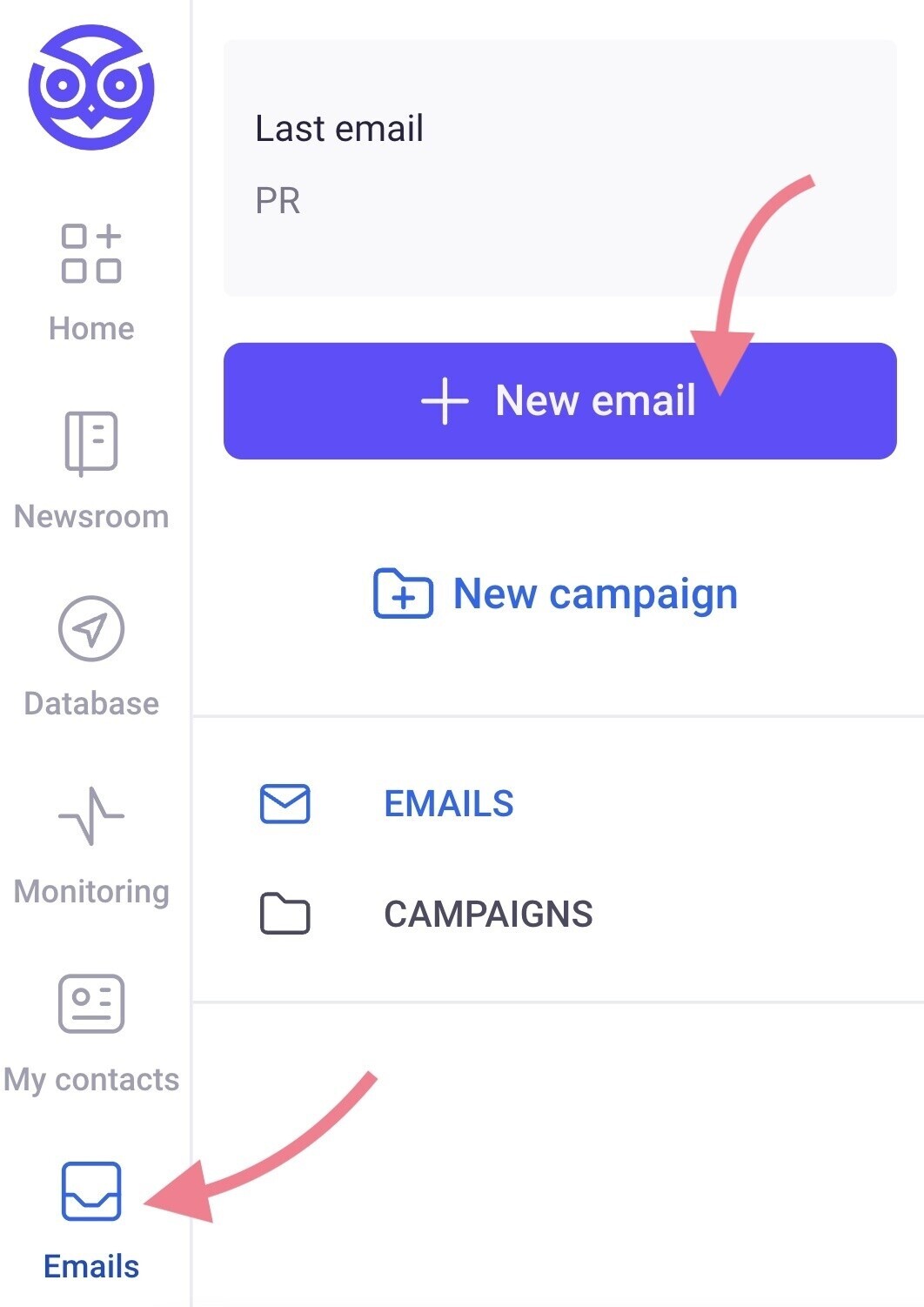
Give your email an “Internal name” and click “Next.”
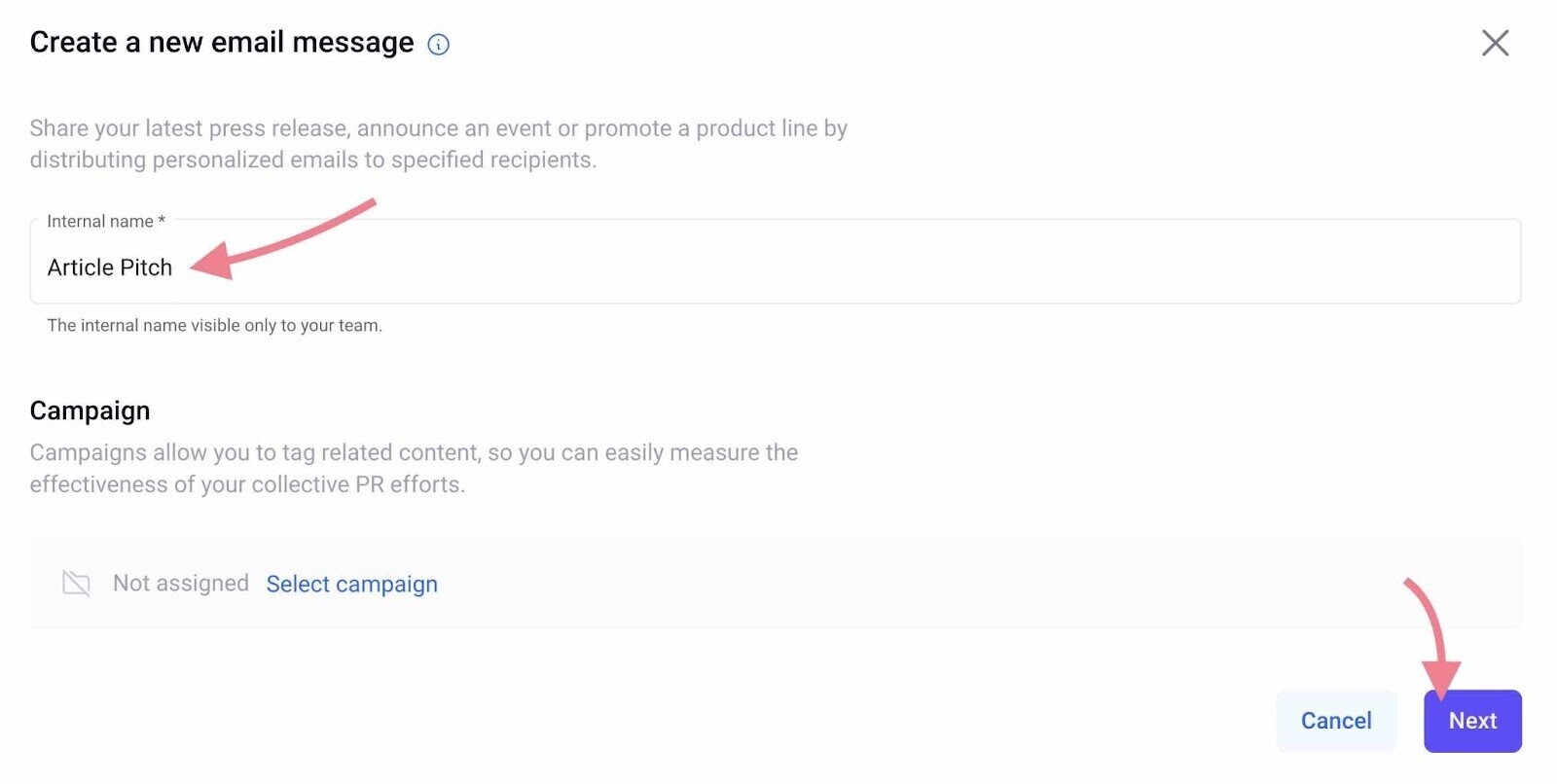
Then, add your recipients.
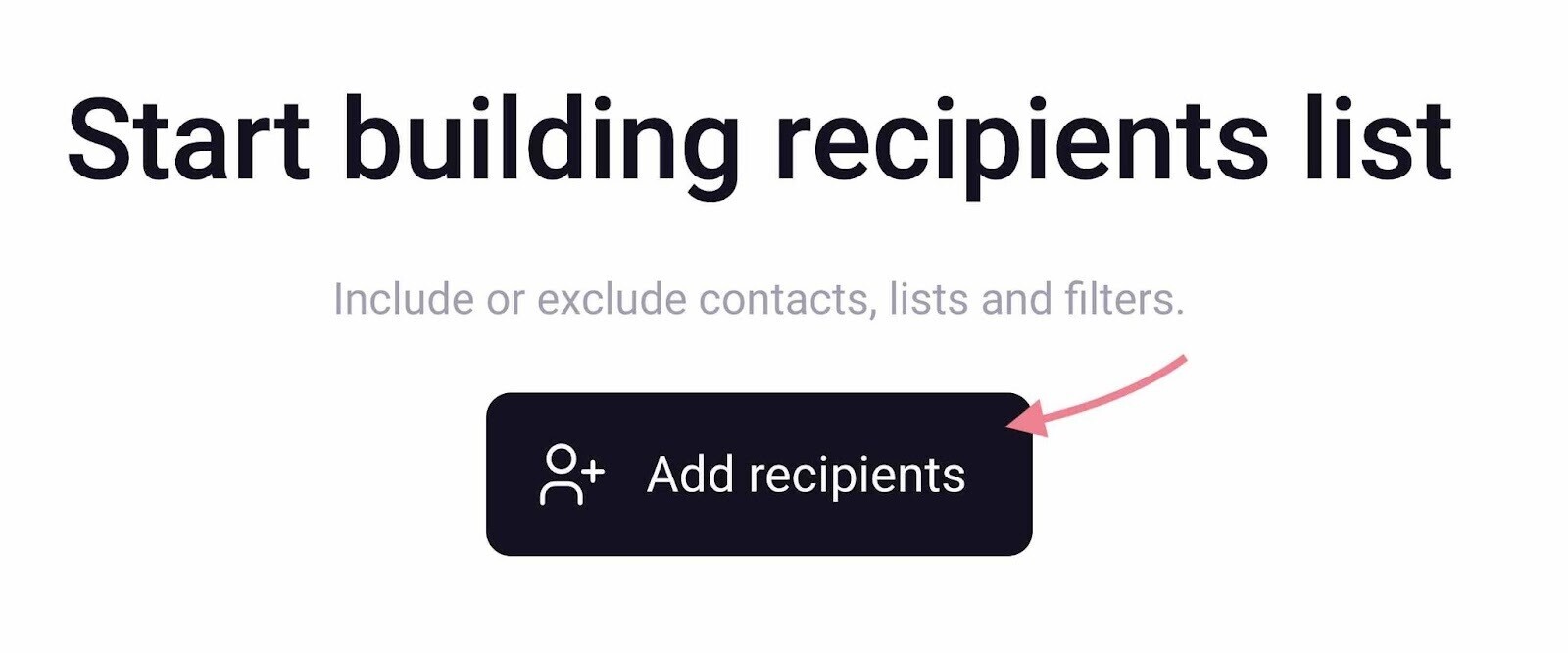
You can choose individual contacts or load a list you have previously saved.
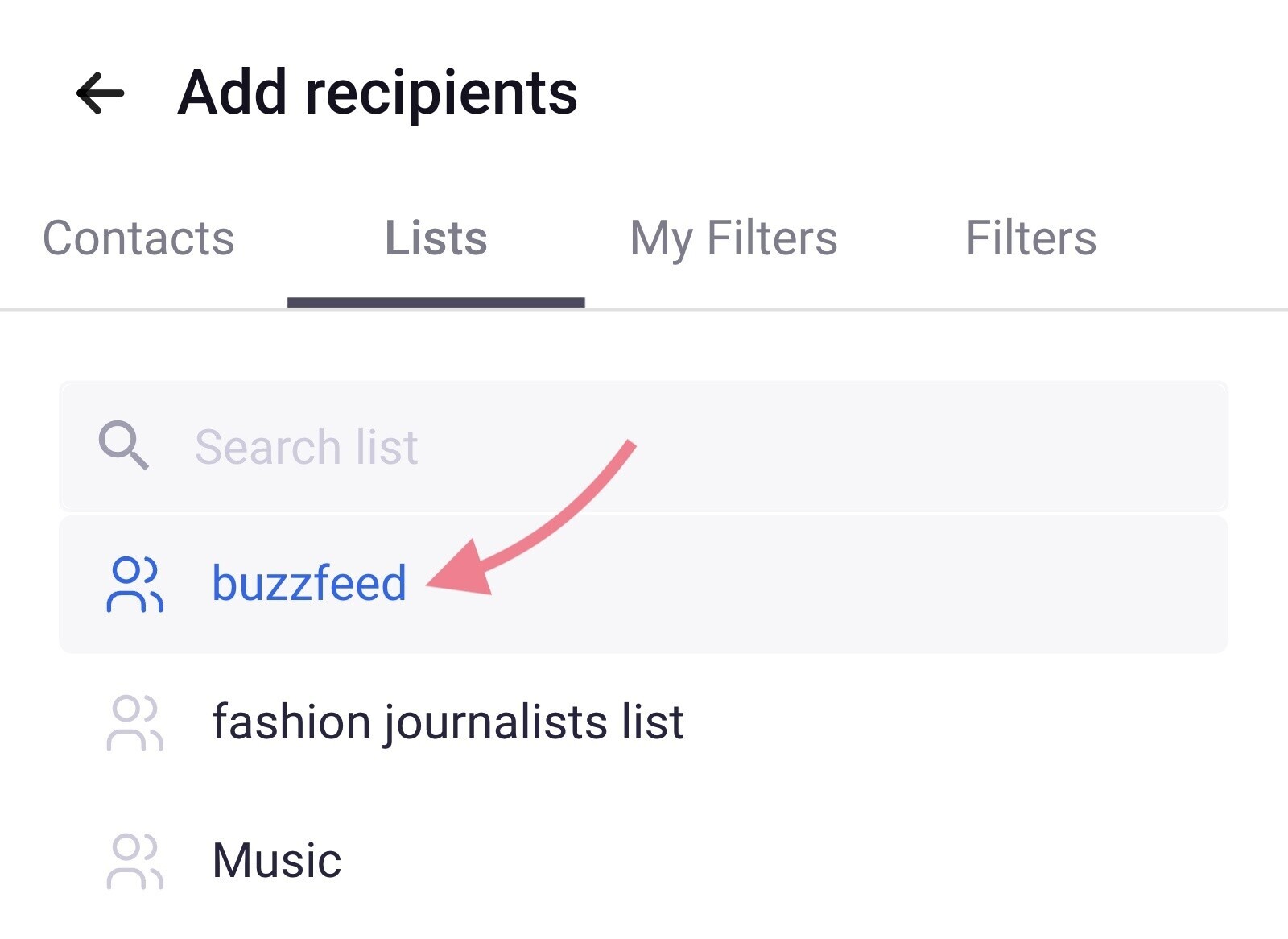
Once you add all your recipients, click “Next.”
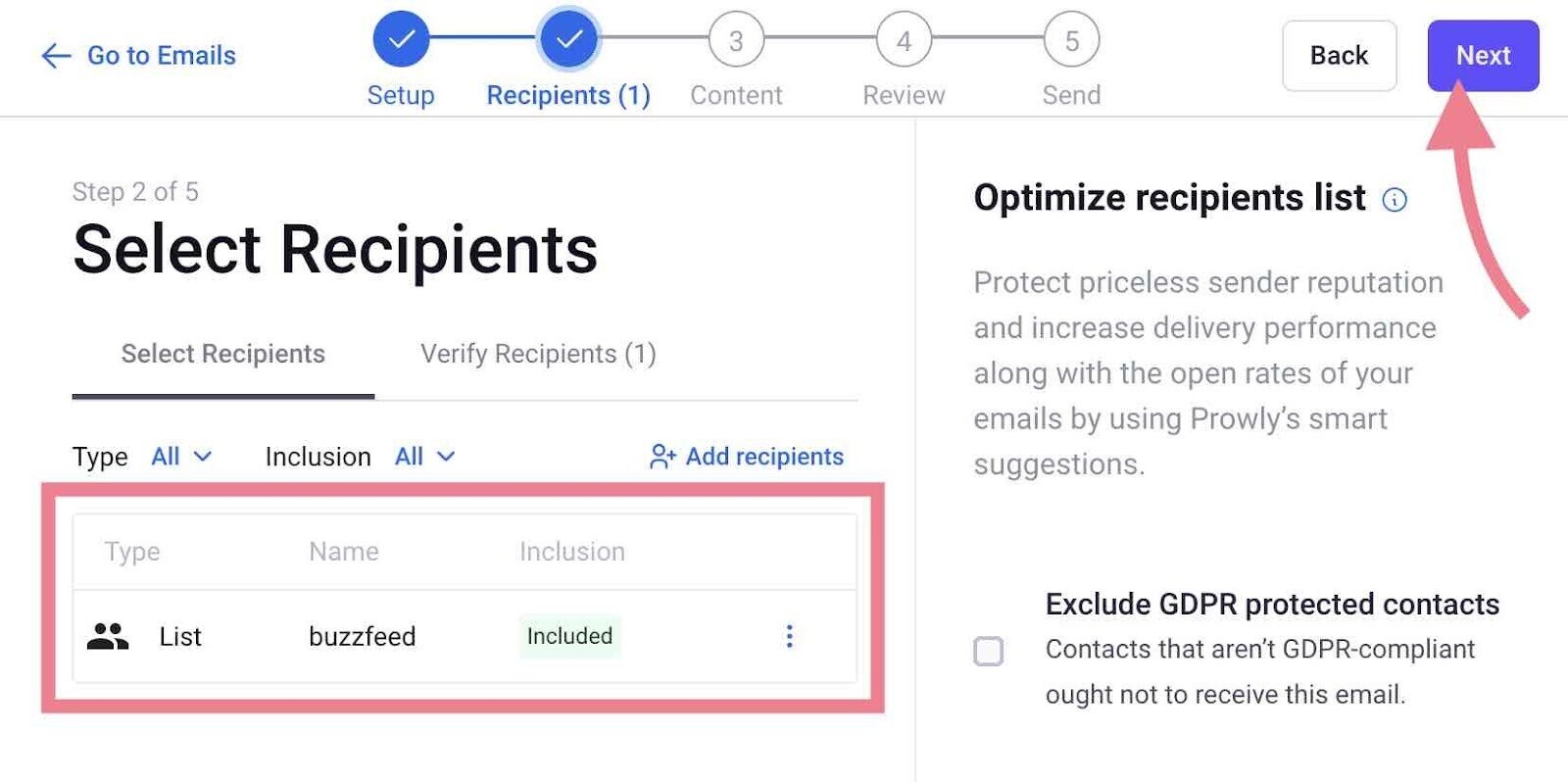
Now, you’ll add your email address.
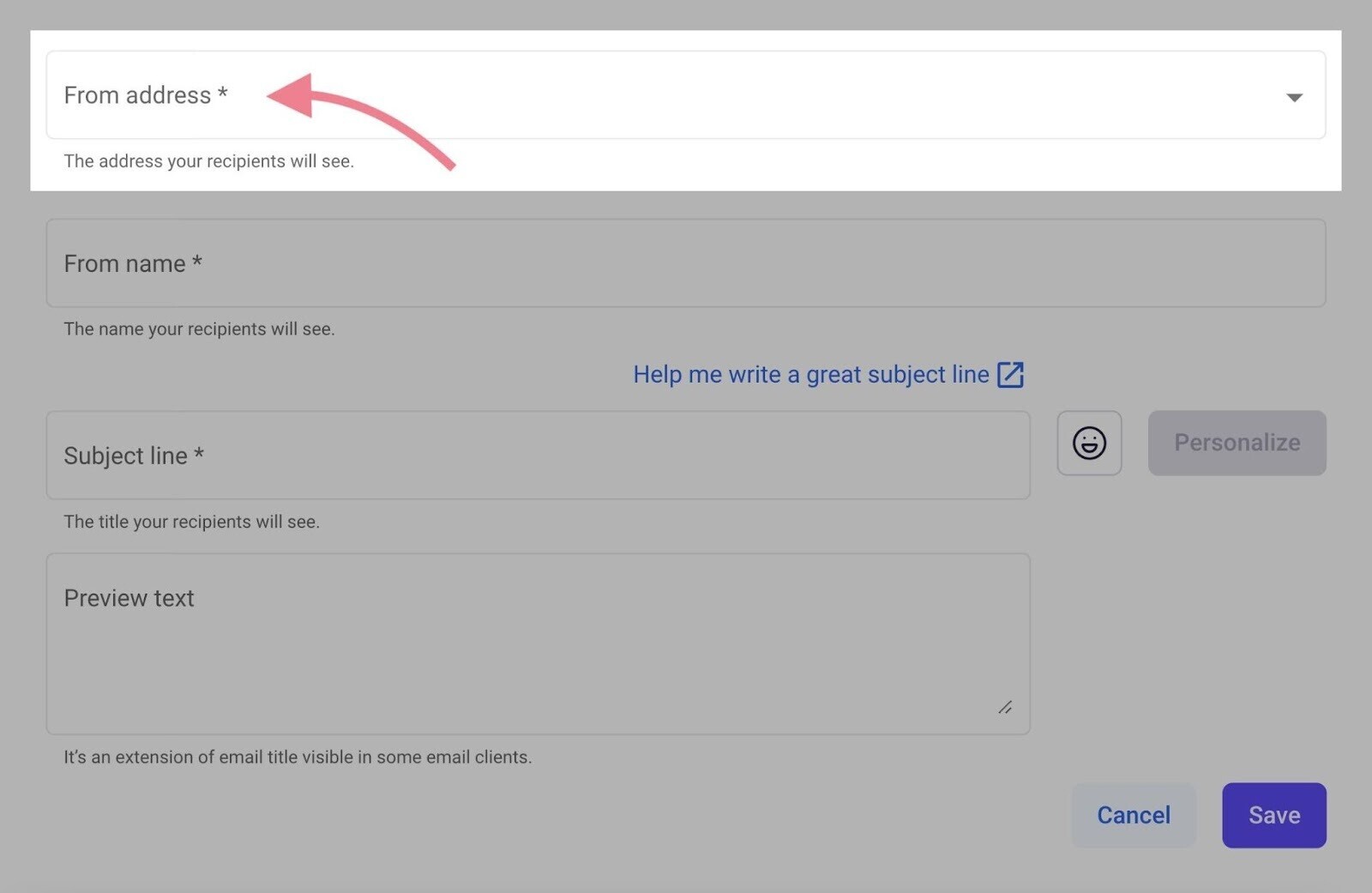
And click “Add new sender.”
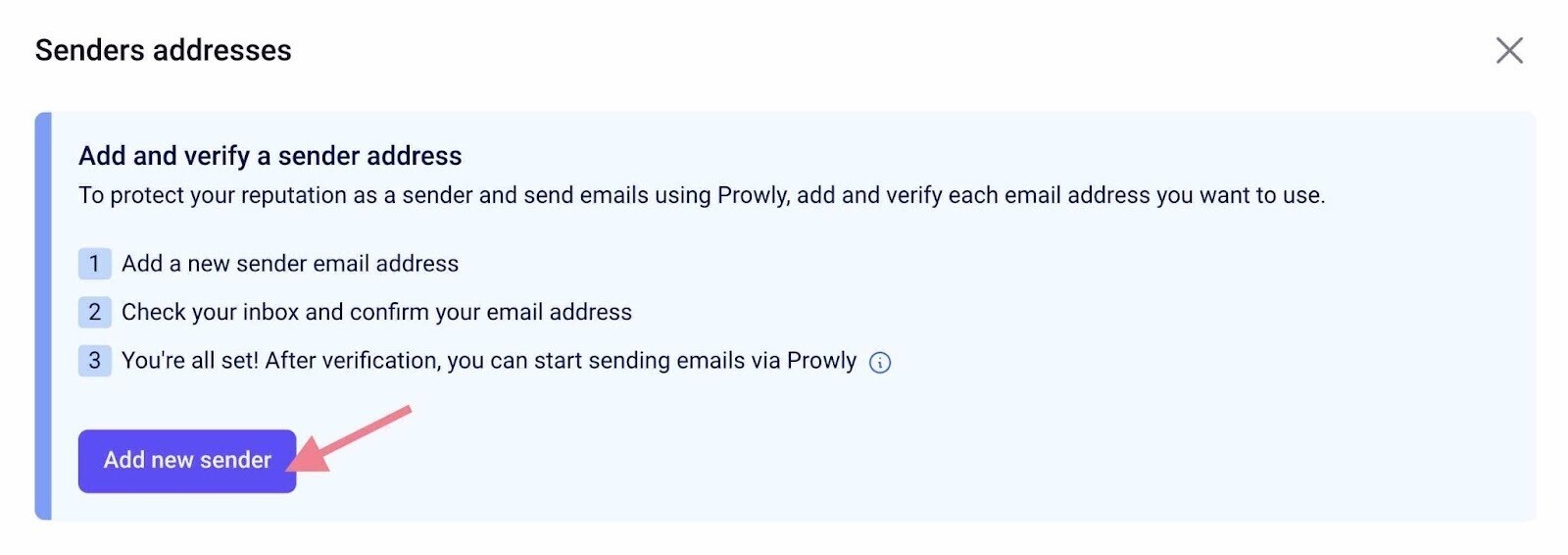
Enter your email information and click “Add.”
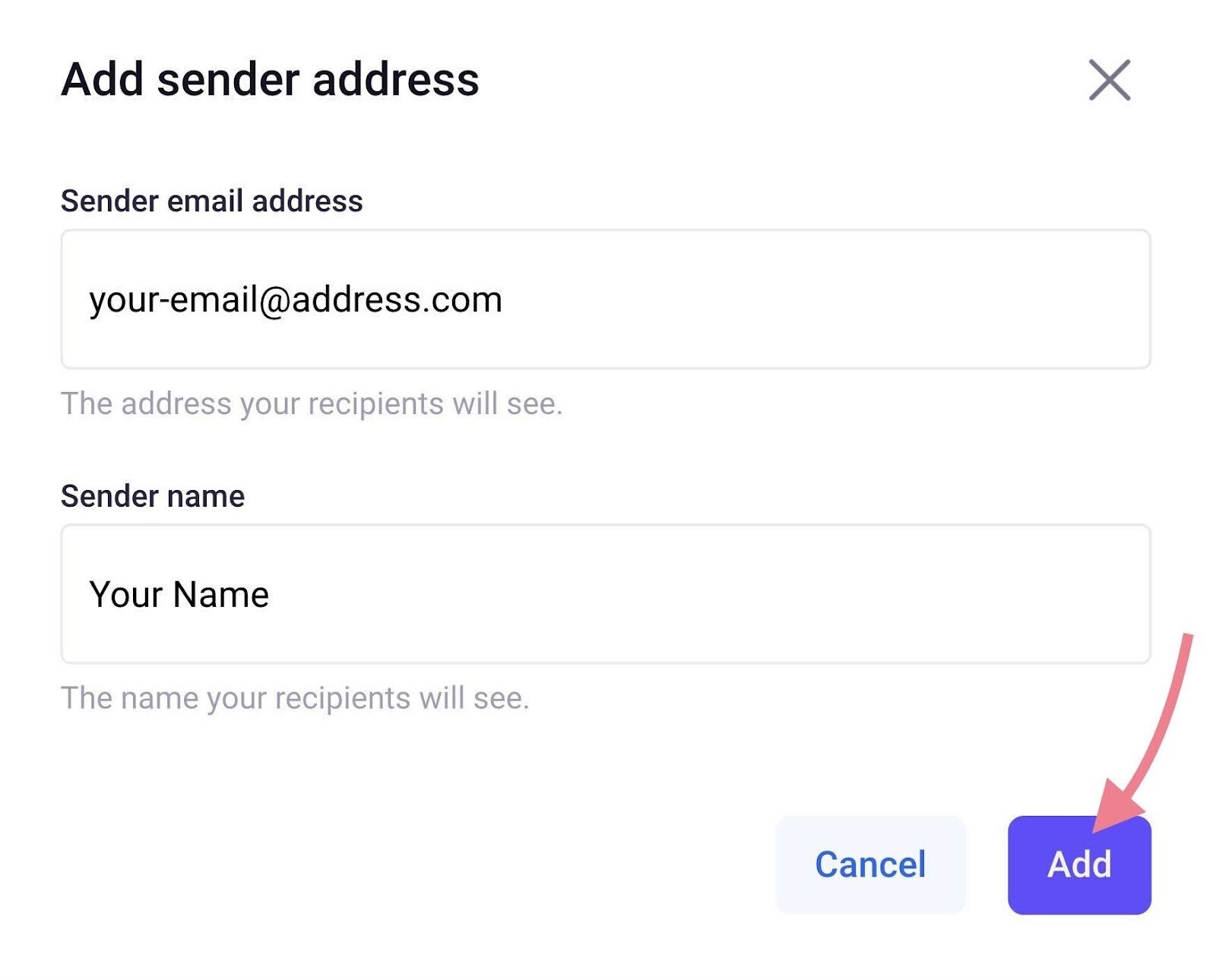
Prowly will send an email to your email ID to verify that it is correct.
Now, you can create your email content. Like adding your name and a subject line.
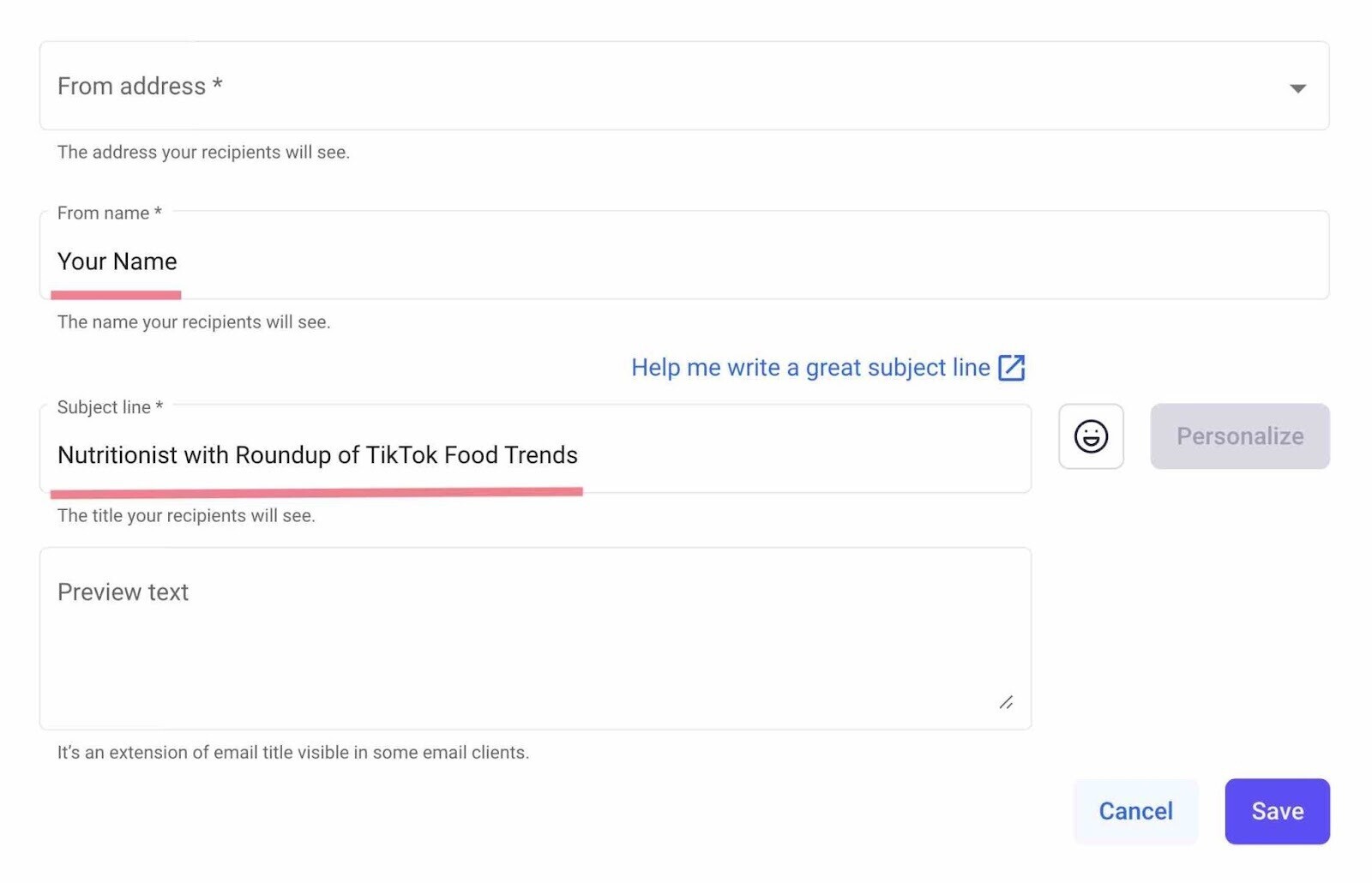
And your email body text.
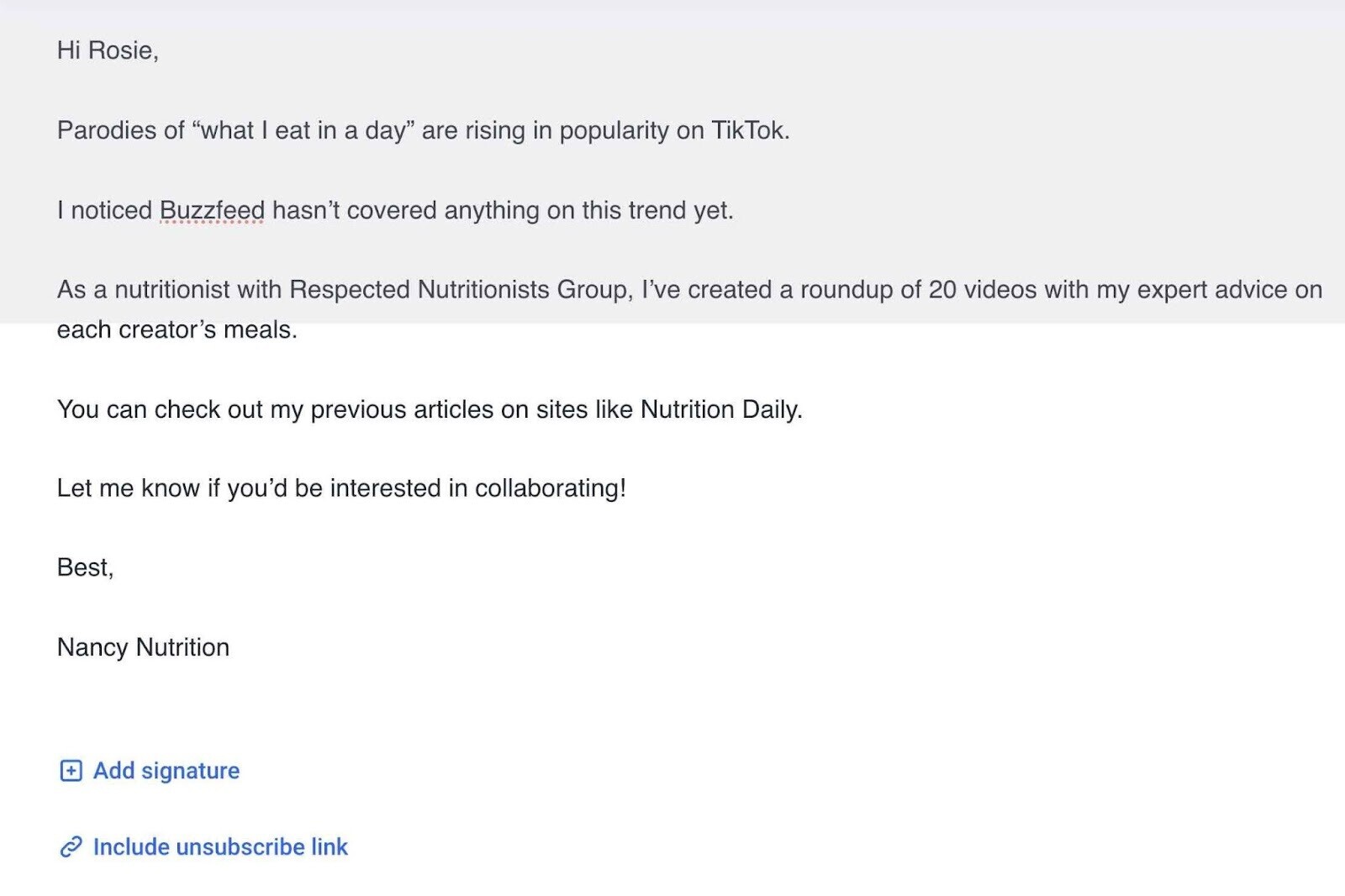
Once you’re happy with the email content, click “Next.”
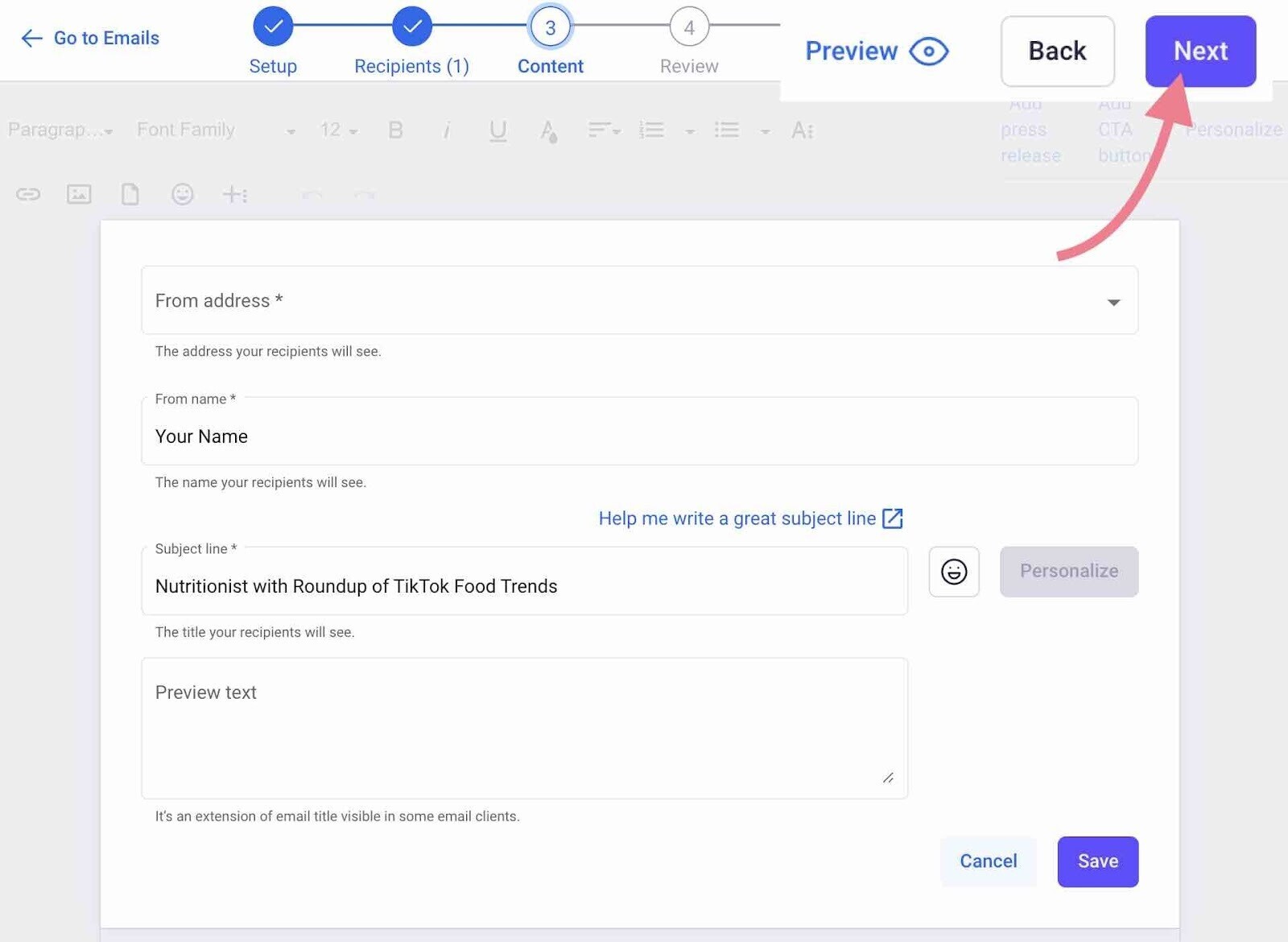
Prowly will ask you to review your email before you send it. You’ll see suggestions and any errors that may block you from sending the email.
Resolve any issues before continuing.
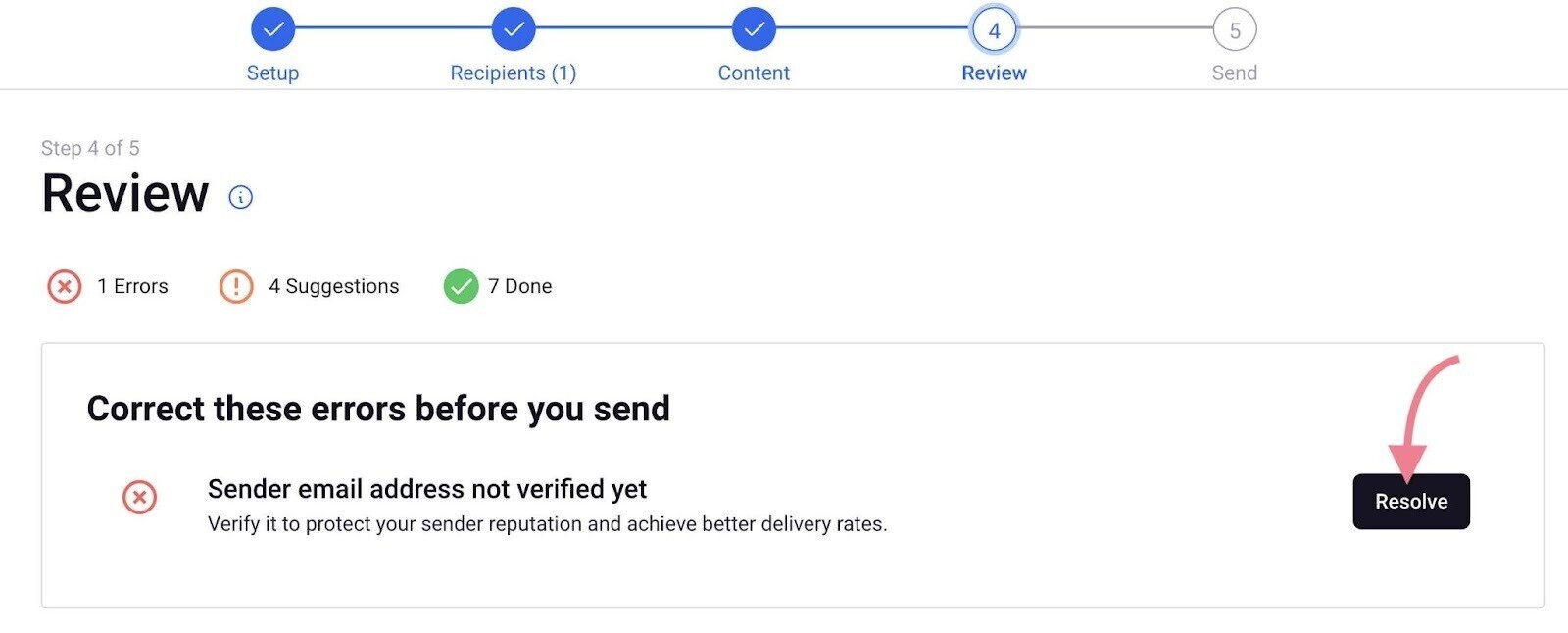
Then, you can send your email or save it as a draft for later.
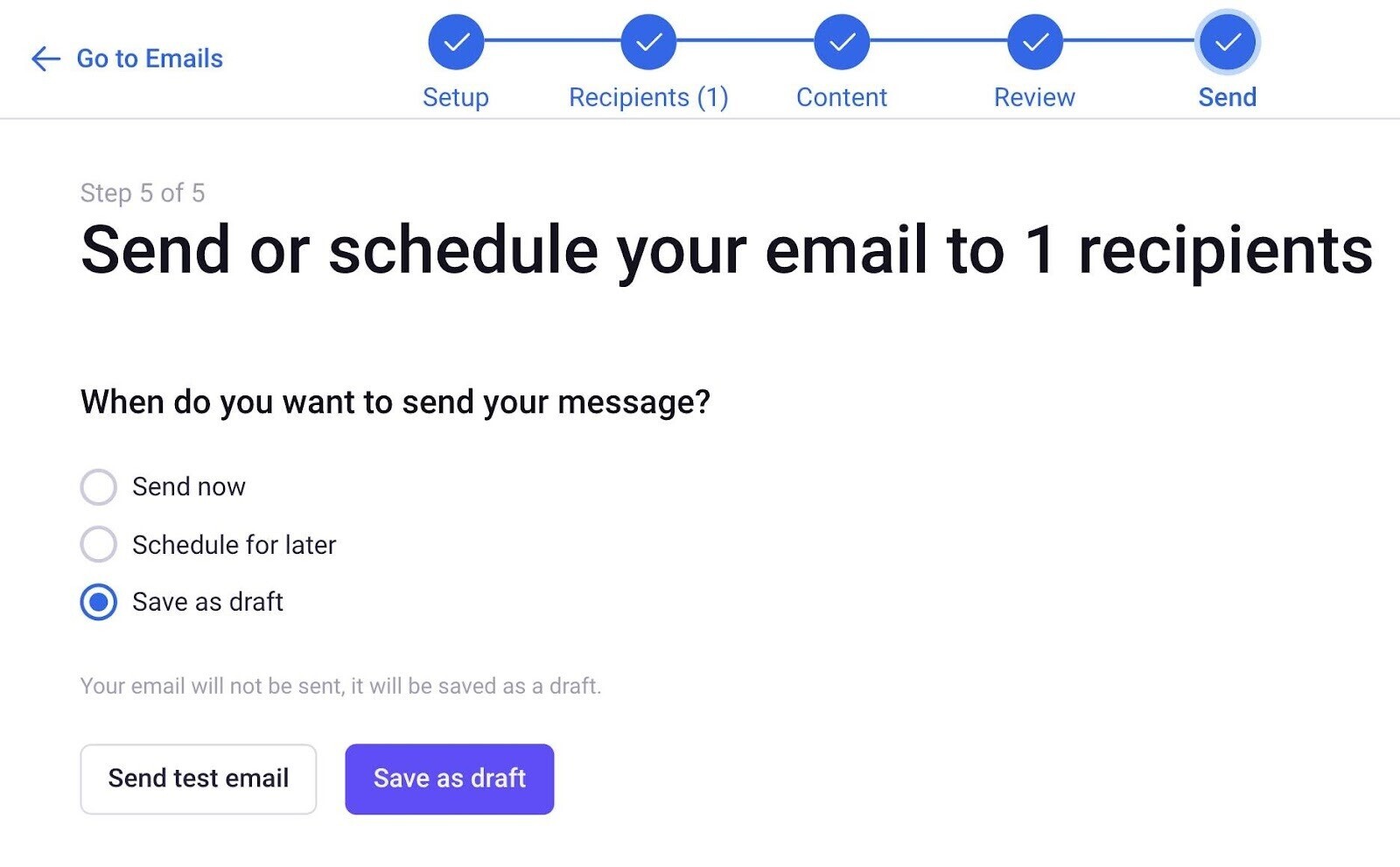
If journalists see your story as a good fit for their publication, they may cover it. And you could receive a backlink in return.
Tip: Maintain your relationships with your contacts. They may choose to highlight your site again in the future.
Learn more: A Guide to Digital PR and Why It’s Important for SEO and Link Building
7. Linkable Assets
A linkable asset is a type of content that attracts backlinks naturally.
Examples include the following:
- Infographics
- Original research and data studies
- Calculators
- Free tools
- In-depth guides and tutorials
In short, engaging content tends to earn links naturally.
Take this interactive infographic link building example from animagraffs.com:
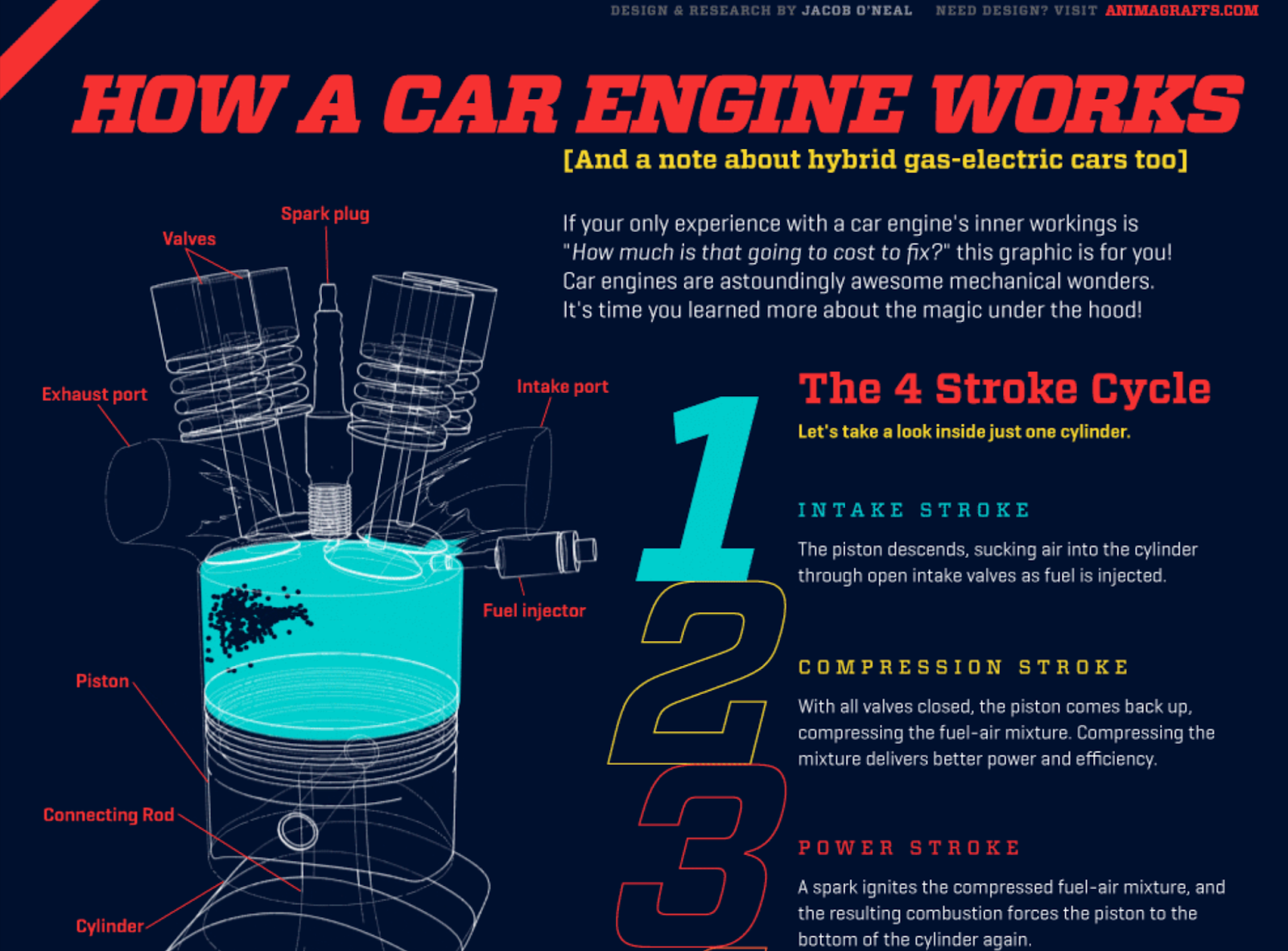
When we analyze its performance in Semrush’s Backlinks Analytics tool, we see that it has 775 backlinks from 277 referring domains. That’s a lot of backlinks.
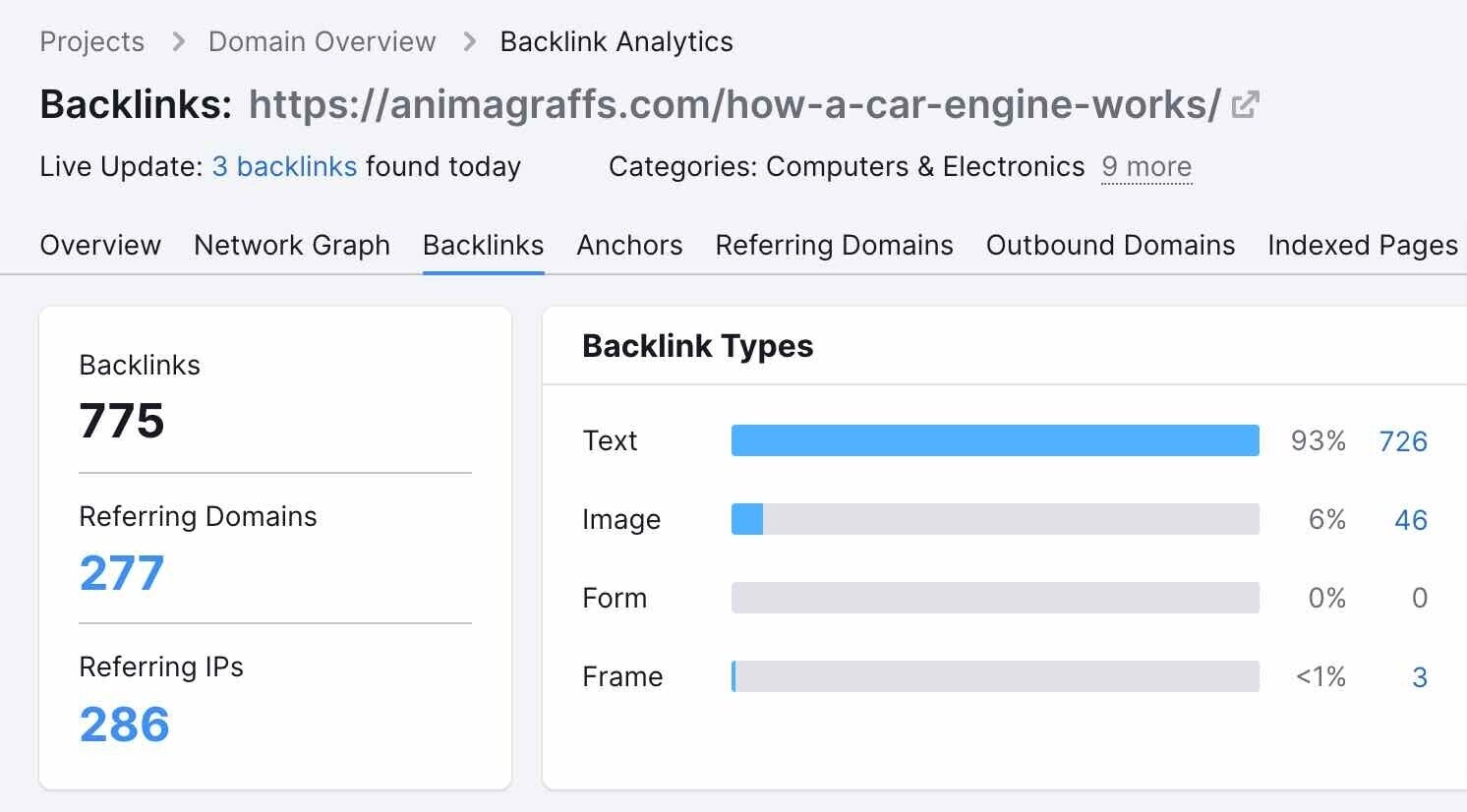
But what type of linkable assets should you create for your own website?
Find out what works for your industry by studying your competitors’ webpages for inspiration.
Open Semrush’s Backlink Analytics tool and plug in your competitor’s website. (In this example, we’ll use Backlinko because they’re very successful at building backlinks.)
Then click “Analyze.”

Go to the “Indexed Pages” report to see what kinds of assets attract the most backlinks.
This site’s data studies and original research attract a lot of backlinks:
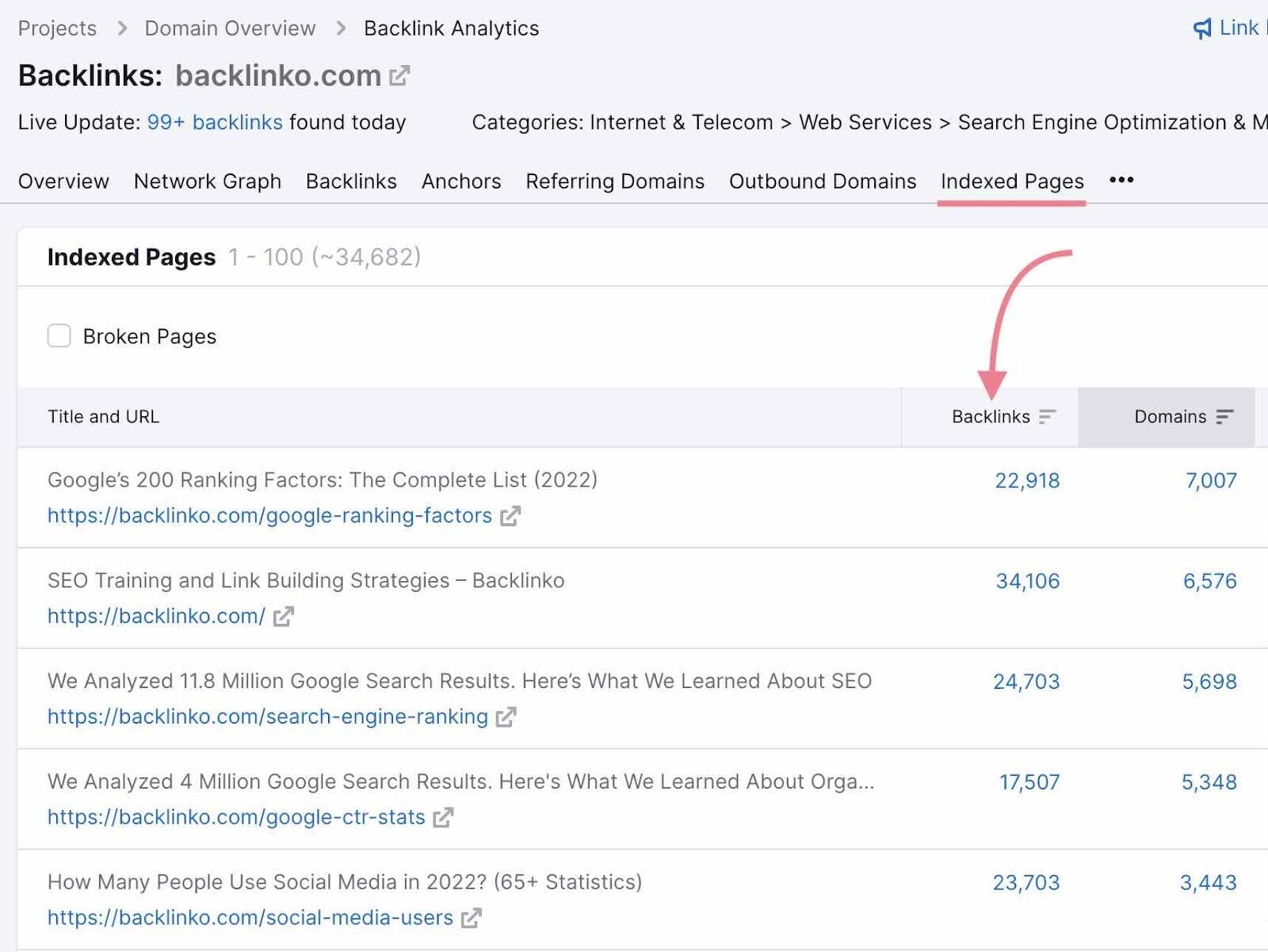
If you’re also in the SEO niche, try creating similar guides or studies to earn backlinks.
But don’t just repeat the same information. People will only want to link to your resource if it truly is the best, most comprehensive option.
So use this step as a starting point to creating your own original content.
Pro tip: Learn the ins and outs of creating linkable assets from Backlinko Founder Brian Dean in this linkable assets course.
8. Guest Blogging
Guest blogging is the process of writing and publishing a blog post for another website. Which typically results in a backlink to your site.
It’s still one of the most popular link building ideas. But there’s a right and a wrong way to guest post.
If you’re guest blogging on any site available just to get more backlinks, you’re violating Google’s guidelines.
Instead, partner with relevant brands in your niche to create useful, valuable content.
You’ll still get credibility and brand exposure. But you won’t violate Google’s link spam policies.
Now that we’ve covered the basics—how do you find relevant guest posting opportunities?
One simple method is to use Google search operators.
Here’s one query you can use to find sites in your niche that accept guest posts:
Your keyword + intitle:“write for us”
Say you want to find guest blogging opportunities for health and fitness websites. Search for the following:
Health + intitle:“write for us”
You’ll find websites that accept guest articles.
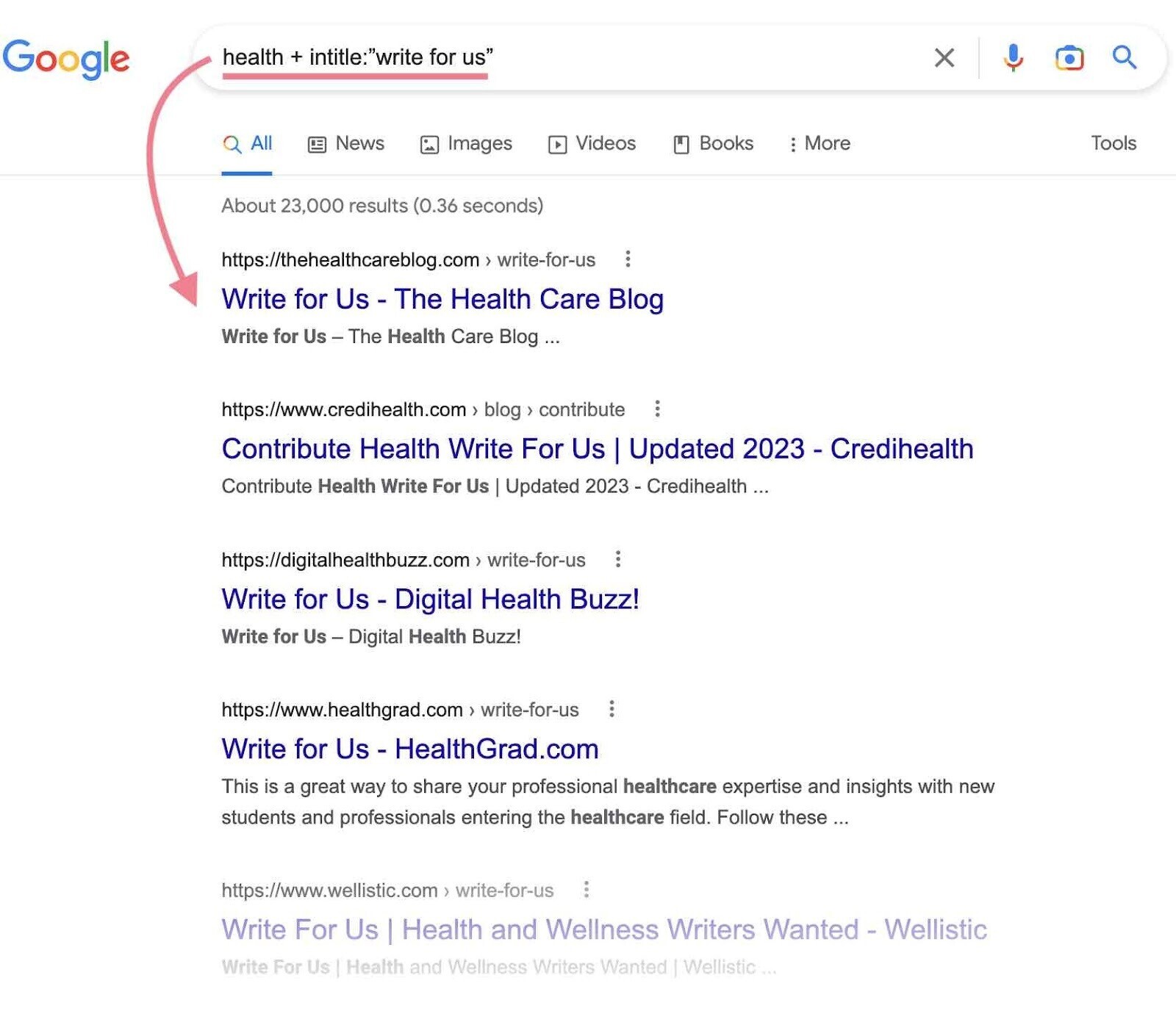
But everyone can find prospects this way. So these sites probably get tons of guest post pitches.
Stand out by reaching out to relevant sites even if they don’t advertise guest posting opportunities. Many people are willing to feature free, high-quality content that’s relevant to their site.
You’ll get exposure, and the other website will get potential traffic to their website. It’s a win-win situation.
When you reach out, always include a list of topics you’d like to cover. And ensure they’re all unique blog post ideas.
Read our full guide to guest blogging for more information on best practices.
Test Out the Best Link Building Tips Today
Dozens of SEO link building strategies can help you build high-quality backlinks. These eight ideas are a great place to start.
If you’re a Semrush user, use the Link Building Tool to set up your first link building campaign. The tool allows you to build high-quality links at scale—which can help improve your site’s rankings.
Looking to learn more about link building?
Check out the resources below to expand your link building knowledge:
Source link : Semrush.com
